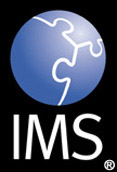
Final Specification
Version 1.0
 |
IMS Learner Information Packaging XML Binding
Final Specification |
Copyright © 2001 IMS Global Learning Consortium, Inc. All Rights Reserved.
The IMS Logo is a
trademark of IMS Global Learning Consortium, Inc.
Document Name:IMS
Learner Information Packaging Best Practice & Implementation Guide
v1.0
Revision: 9 March 2001
IPR and Distribution Notices
Recipients of this document are requested to submit, with their comments, notification of any relevant patent claims or other intellectual property rights of which they may be aware that might be infringed by any implementation of the specification set forth in this document, and to provide supporting documentation.
IMS takes no position regarding the validity or scope of any intellectual property or other rights that might be claimed to pertain to the implementation or use of the technology described in this document or the extent to which any license under such rights might or might not be available; neither does it represent that it has made any effort to identify any such rights. Information on IMS's procedures with respect to rights in IMS specifications can be found at the IMS Intellectual Property Rights web page: http://www.imsglobal.org/ipr/imsipr_policyFinal.pdf.
Copyright © 2001 IMS Global Learning Consortium. All Rights Reserved.
If you wish to copy or distribute this document, you must complete a valid Registered User license registration with IMS and receive an email from IMS granting the license to distribute the specification. To register, follow the instructions on the IMS website: http://www.imsglobal.org/specificationdownload.cfm.
This document may be copied and furnished to others by Registered Users who have registered on the IMS website provided that the above copyright notice and this paragraph are included on all such copies. However, this document itself may not be modified in any way, such as by removing the copyright notice or references to IMS, except as needed for the purpose of developing IMS specifications, under the auspices of a chartered IMS project group.
Use of this specification to develop products or services is governed by the license with IMS found on the IMS website: http://www.imsglobal.org/license.html.
The limited permissions granted above are perpetual and will not be revoked by IMS or its successors or assigns.
THIS SPECIFICATION IS BEING OFFERED WITHOUT ANY WARRANTY WHATSOEVER, AND IN PARTICULAR, ANY WARRANTY OF NONINFRINGEMENT IS EXPRESSLY DISCLAIMED. ANY USE OF THIS SPECIFICATION SHALL BE MADE ENTIRELY AT THE IMPLEMENTER'S OWN RISK, AND NEITHER THE CONSORTIUM, NOR ANY OF ITS MEMBERS OR SUBMITTERS, SHALL HAVE ANY LIABILITY WHATSOEVER TO ANY IMPLEMENTER OR THIRD PARTY FOR ANY DAMAGES OF ANY NATURE WHATSOEVER, DIRECTLY OR INDIRECTLY, ARISING FROM THE USE OF THIS SPECIFICATION.
ABOUT
THIS DOCUMENT
LIST
OF CONTRIBUTORS
REVISION
HISTORY
Figure 1.1
The IMS Learner Information Package (LIP) core data structures
Figure
3.1 <learnerinformation> elements
Figure 3.2
<identification> elements
Figure 3.3
<formname> elements
Figure 3.4
<name> elements
Figure 3.5
<address> elements
Figure 3.6
<street> elements
Figure 3.7
<contactinfo> elements
Figure 3.8
<demographics> elements
Figure
3.9 <agent> elements
Figure
3.10 <goal> elements
Figure
3.11 <qcl> elements
Figure
3.12 <activity> elements
Figure
3.13 <definition> elements
Figure
3.14 <testimonial> elements
Figure
3.15 <evaluation> elements
Figure
3.16 <competency> elements
Figure
3.17 <transcript> elements
Figure
3.18 <accessibility> elements
Figure
3.19 <language> elements
Figure
3.20 <preference> elements
Figure
3.21 <eligibility> elements
Figure
3.22 <disability> elements
Figure
3.23 <interest> elements
Figure
3.24 <affiliation> elements
Figure
3.25 <role> elements
Figure
3.26 <securitykey> elements
Figure
3.27 <relationship> elements
Figure
3.28 <contentype> elements
Figure
3.29 <description> elements
Figure
3.30 <date> elements
Figure
3.31 <status> elements
Figure
3.32 <product> elements
Figure
3.33 <typename> elements
Figure
3.34 <fieldlabel> elements
Figure
3.35 <organization> elements
Figure
3.36 <exrefrecord> elements
Figure
3.37 <sourcedid> elements
Figure 4.1
XML schema inclusion hierarchy
IMS Learner Information Package is based on a data model that describes those characteristics of a learner needed for the general purposes of:
The specification supports the exchange of learner information among learning management systems, human resource systems, student information systems, enterprise e-learning systems, knowledge management systems, resume repositories, and other systems used in the learning process. In this document such systems will be called learner information systems regardless of any other functionality they possess or roles they fulfil. The IMS Learner Information Package specification does not address requests for learner information or the exchange transaction mechanism.
IMS Learner Information specifications are designed to meet the following requirements:
The IMS project recognizes the need to:
IMS Learner Information Package enables the inclusion of mechanisms for maintaining privacy and protecting the integrity of data with all data that comprises learner information. The specification cannot, however, specify the form, format, or type of these mechanisms or policies for their use. These must be determined by specific implementations in accordance with their requirements.
IMS Learner Information Package is a structured information model. An XML binding is included but is not meant to exclude other bindings. The information model contains both data and meta-data about that data. The model defines fields into which the data can be placed and the type of data that may be put into these fields. Typical data might be the name of a learner, a course or training completed, a learning objective, a preference for a particular type of technology, and so on. Meta-data about each field can include:
This meta-data is available for each and every field in the information model, either directly or via inheritance.
The learner information model can be viewed in three different ways:
All three ways are explained in the specification. The Learner information is separated into eleven main categories (as shown in Figure 1.1). These structures have been identified as the primary data structures that are required to support learner information. This composite approach means that only the required information needs to be packaged and stored.

Figure 1.1 The IMS Learner Information Package (LIP) core data structures.
These categories were chosen to meet the requirements of a large variety of use cases and to facilitate mapping among IMS and other relevant specifications. Within each category several data elements and structures are defined. Some of these are specified explicitly as data types (language strings, for the most part) and others are defined as recursive hierarchical structures. In addition, data may be defined by referencing mechanisms. The referencing mechanisms supported are internal references, references to an external learner information system, and references via a URI.
The learning information meta-data (contained within the ‘contentype’ structure shown in Figure 1.1) is broken into four categories:
All learning information data elements have meta-data sub-elements with the exception of atomic elements that can always inherit their meta-data. For example, in the Identification category, meta-data is associated with the Name element but not with its constituent elements since it is felt that the meta-data for the constituent elements cannot change independently of the meta-data for the Name element itself.
The IMS Learner Information Package (LIP) XML Binding describes the XML Schema binding of the LIP Information Model. A Document Type Definition (DTD) representation is also included for the binding but this is not formally supported. Version 1.0 of the eXtensible Markup Language (XML) specification of the World Wide Web Consortium (W3C) is used.
This binding has been derived from the agreed IMS Learner Information Package Information Model specification [LIP, 01b] and conforms to the XML Version 1.0 specification [XML, 98] of the W3C.
The structure of this document is:
| valign=top>
2. XML Basics |
valign=top>
A brief description of the components within an XML schema; |
| valign=top>
3. Narrative Description of the XML Binding |
valign=top>
The XML Schema used to describe the Learner Information; |
| valign=top>
4. Physical Realisation of the XML Binding |
valign=top>
The manner in which the XML binding is realised as a series of separated but related XSD files; |
| valign=top>
5. Example XML Schema |
valign=top>
Examples of the XML schema as applied to typical learner information interchange; |
| valign=top>
Appendix A - LIP DTD (Uncommented) |
valign=top>
A copy of the uncommented DTD (this is informative only and is not a formally supported binding). |
| ANSI | American National Standards Institute |
| CDATA | Character Data |
| DTD | Document Type Definition |
| EDI | Electronic Data Interchange |
| FE | Further Education |
| GUI | Graphical User Interface |
| HE | Higher Education |
| HRMS | Human Resource Management System |
| IEEE | Institute of Electronic & Electrical Engineers |
| JPEG | Joint Photographic Expert Group |
| LIP | Learner Information Packaging |
| LLL | Life-long Learning |
| LTSC | Learning Technology Standards Committee |
| NVC | National Validation Center |
| PAPI | Public & Private Information |
| PCDATA | Parsed Character Data |
| QTI | Question & Test Interoperability |
| SIF | Schools Interoperability Framework |
| UCAS | University Council for Admissions Services |
| UML | Unified Modelling Language |
| URI | Universal Resource Identifier |
| W3C | World Wide Web Consortium |
| XDR | XML Data Reduced |
| XML | Extensible Mark-up Language |
| XSD | XML Schema |
[ANSI, 98] Student Educational Record (Transcript), ANSI ASC X.12-TS130, ANSI, April 1998.
[CP, 00a] IMS Content Packaging Information Model, T.Anderson, W.Young, C.Moffatt, Version 1.0, IMS, May 2000.
[CP, 00b] IMS Content Packaging XML Binding, T.Anderson, W.Young, C.Moffatt, Version 1.0, IMS, May 2000.
[CP, 00c] IMS Content Packaging Best Practice and Implementation Guide, T.Anderson, W.Young, C.Moffatt, Version 1.0, IMS, May 2000.
[Enterprise, 99a] IMS Enterprise Information Model, G.Collier, W.Veres and T.Anderson, Version 1.01, IMS, December 1999.
[Enterprise, 99b] IMS Enterprise XML Binding, G.Collier, W.Veres and T.Anderson, Version 1.01, IMS, December 1999.
[Enterprise, 99c] IMS Enterprise Best Practice and Implementation Guide, G.Collier, W.Veres and T.Anderson, Version 1.01, IMS, December 1999.
[Gestalt, 00] Gestalt: WP4 - Integrating IMS Enterprise, PAPI and Gestalt UOM Data Models, version 3.0, P.Foster, Gestalt Doc No: FC:/MAN/REPORTS/022GESTALT/D401/GestaltEnterprisePAPI_3, March 2000.
[Gestalt, 99] Gestalt: WP5 - Object (Interfaces) Specification, V.Wade, K.Riley, B.Banks, P.Foster, N.Evans-Mudie, Y.Nicol, P.Doherty, Gestalt Doc No: A367/TCD/WP05/DS/L/008/b1, October 1999.
[HR, 00a] Resume DTD, HR-XML Consortium, June 2000, http://www.hr-xml.org/.
[HR, 00b] Candidate DTD, HR-XML Consortium, June 2000, http://www.hr-xml.org/.
[LIP, 00a] Profiles Interchange Requirement Specification, G.Collier, T.Probart and C.Smythe, Version 1.0, IMS, March 2000.
[LIP, 01b] IMS Learner Information Package Information Model Final Specification, R.Robson, C.Smythe and F.Tansey, Version 1.0, IMS, March 2001.
[LIP, 01c] IMS Learner Information Packaging Best Practices & Implementation Guide Final Specification, R.Robson, C.Smythe and F.Tansey, Version 1.0, IMS, March 2001.
[MD, 99a] IMS Meta-data Information Model, T.Wason, Version 1.0, IMS, September 1999.
[MD, 99b] IMS Meta-data XML Binding, T.Wason, Version 1.0, IMS, September 1999.
[MD, 99c] IMS Meta-data Best Practice and Implementation Guide, T.Wason, Version 1.0, IMS, September 1999.
[Messaging, 99] Proposal for the Inclusion of a Run Time Messaging Service in the IMS 1.0 Specifications, Ken Schweller, IMS, May 1999.
[PAPI, 98] IEEE PAPI Specification - Learning Technology: Public and Private Information, Version 6.0, IEEE LTSC P1484, June 2000.
[QTI, 01] IMS Question & Test Interoperability: ASI Information Model, C.Smythe and E.Shepherd, Version 1.1, IMS, March 2001.
[Saba, 00] Profile Format: Design Specification, Daniel Lipkin, Saba Inc, May 2000.
[SIF, 99] Schools Interoperability Framework Preliminary Implementation Specifications, Version 1.0, SIF, November 1999.
[vCard, 98] The vCard v3.0 XML DTD, F.Dawson, IETF Draft, June 1998.
[XML, 98] XML Version 1.0 Specification of the W3C, http://www.w3.org./TR/1998/REC-xml-19980210, World Wide Web Consortium, 1998.
The Learner Information Packaging data model has been defined as a hierarchy. Hierarchical models are convenient for representing data consisting of many elements and sub-elements. XML is perfectly suited for representing hierarchical models. An XML document is a hierarchy comprised of elements that have contents and attributes.
An element is a component of a document that has been identified in a way a computer can understand. Each element has a tag name. When a tag name is shown as
“<TAGNAME>”, with less-than and greater-than symbols before and after the tag name, it serves as the start-tag to mark the beginning of an element. When that same tag name has a forward slash “/” added, it serves as an end-tag such as
“</TAGNAME>”. An element may have contents between its start and end-tags and may have one or more attributes. When an XML element has a start and end-tag (also called an opening and closing tag) with a common name, it is considered to be “well-formed” XML. The contents of an element are placed between the start and end-tags as shown below:
<TAGNAME>contents</TAGNAME>
An element may contain other elements, Parsed Character Data (PCDATA), Character Data (CDATA), or a mixture of PCDATA and elements. The allowable contents of an element are its content model. PCDATA really means any character string that does not contain elements. PCDATA is what the bulk of elements will use between their start and end-tags. CDATA is different in that it is a method for adding any character data that should not be processed. For example, you could add some Java script code instructions using a CDATA section. A CDATA section tells the parser not to look for any markup until after it locates the end of the CDATA section.
An attribute provides additional information about an element. Attributes are a way of attaching characteristics or properties to the elements of a document. An element may have more than one attribute and they are contained within the start tag of an element. Attributes are represented by an attribute name followed by an equal sign and the attribute value in quotation marks:
<timeframe> <begin restrict=”1”>1999-07-23</begin> </timeframe>
In this example the <timeframe> element contains another element, the <begin> element. The <begin> element has one attribute “restrict”, with the value 1. The value for the element <begin> is “1999-07-23”. These two elements then make up a ‘timeframe begin’ date.
Each element has a unique name, referred to as the tag name. XML is case-sensitive in its processing of tag names. The IMS Learner Information Package XML binding adheres to the following tag name rules:
DOCTYPE
ELEMENT
ATTLIST
ENTITY
The LIP version 1.0 XML binding is defined in an XML-Schema. XML-Schema is the primary XML binding control document format of IMS. The XML-Schema defines elements, their content models, and attributes. It also defines the standard IMS vocabularies. The XML-Schema defines the element types and attribute groups separately from the elements. This serves three purposes:
The XML Schema for the IMS LIP is named: ims_lip_rootv1p0.xsd.
The tag name, content model, and attributes of elements are defined in a Document Type Definition (DTD) statement. These may exist as an external file or a block of text internal to an XML document. Internal DTDs are used to override elements defined in external DTD files, so an internal DTD should be used with care. The DTD defines the elements that may be used, and may define the contents of the elements.
Some XML editors may make use of a DTD to help guide the developer in creating the proper elements at the proper locations in an XML file. Other developers will make use of the DTDs to validate their XML documents to ensure their document is consistent with all of the element names and locations defined in the DTD. An XML document is valid if it has an associated document type declaration and if the document complies with the constraints expressed in it. Details of the construction of DTDs are outside the scope of this document, but links to the XML Version 1.0 specification are included in the References (sub-section 1.5) of this document.
The DTD for the IMS LIP is named: ims_lipv1p0.dtd
The information specifying the order and usage of allowable contents for an element are its content model. The content model is declared in a DTD (see below). The declaration of the content model is of the general form:
<!ELEMENT tagname (ContentModel)>
The SHORT element can again serve as an example of how an element is declared with its content model:
<!ELEMENT short (#PCDATA)>
This element will contain character data (#PCDATA) that can be processed. The XML Specification provides more information about the details for creating and interpreting content models.
An example of how the attributes for the element <learnerinformation>is declared in a DTD is found below:
<!ELEMENT learnerinformation (sourcedid, goal?, transcript?, qcl?)>
<!ATTLIST learnerinformation type CDATA #IMPLIED>
The first line declares that there is an element named <learnerinformation> that must have the <sourcedid> element and is additionally allowed to have <goal> and/or <transcript> and/or <qcl> elements as its contents. The second line begins with “!ATTLIST” to start an attribute list declaration for the <learnerinformation> element. The word ‘type’ will serve as the attribute’s name. The allowable value for this attribute must be of type CDATA.
At the end of the example above is the term IMPLIED. It is at this location in the attribute declaration, where a default value for an attribute may be specified. It is also possible to use the keyword REQUIRED which would force a TYPE value to be supplied and there would be no default value. In the example above, the IMPLIED designation means that the designer wants to allow users to omit the value for the attribute without forcing a particular default value.
Within the IMS XML binding, the use of attributes is reserved for information about the structure of the structure of the relevant data object.
A list is a repetition of the contents of an element. In XML, this is accomplished by repeating the containing element: for example, the <learnerinformation> element contains an element <affiliation>. Described in the DTD as:
<!ELEMENT learnerinformation (affiliation*)>
When instantiated in XML a repeating list of ITEM elements would appear:
<learnerinformation> <affiliation> “The first affiliation.”</affiliation>
<affiliation> “The secondaffiliation.”</affiliation>
</learnerinformation>
In this example, the element <affiliation>is repeated. Thus <affiliation> is the containing element for the repeated contents descriptions. The notation for repetitions of an element in a content model follows the XML specification. An asterisk (*) specifies that none or more repetitions of the element may be included in the XML instantiation.
A schema is a formal specification of element names that indicates which elements are allowed in an XML document, and in which combinations. New schema languages, such as those defined in the XML-Schemas Working Group, provide the same baseline functionality as a DTD. However, because these schema languages are extensible, developers can augment them with additional information, such as data types, inheritance and presentation rules. This makes these new schema languages far more powerful than DTDs. For more information about XML schemas, go to http://www.w3.org/XML/Group/Schemas.html.
This specification includes an XML Data Reduced (XDR). Some XML editors may make use of such a schema to help guide the developer in creating the proper elements at the proper locations in an XML file. Other developers will make use of the schema to validate their XML documents and/or to define extensions to the IMS LIP specification. Details of the construction of XDRs are outside the scope of this document.
Some characters used in XML must be escaped when used outside of their XML defined usage as found in Section 2.4 of the XML 1.0 Specification. These characters are ampersand (&), less than (<), greater than (>), apostrophe(‘) and the double-quotes character(“). These characters may be represented using either numeric character references or the strings “,&”, “<”, “>”, “'”, and “"”. Below is a more complete quote from the W3C XML specification:
Quote from Extensible Markup Language (XML) 1.0
W3C Recommendation
10-February-1998
2.4 Character Data and Markup
Text consists of intermingled character data and markup. Markup takes the form of start-tags, end-tags, empty-element tags, entity references, character references, comments, CDATA section delimiters, document type declarations, and processing instructions.
All text that is not markup constitutes the character data of the document.
The ampersand character (&) and the left angle bracket(<) may appear in their literal form only when used as markup delimiters or within a comment, a processing instruction or a CDATA section. They are also legal within the literal entity value of an internal entity declaration; see “4.3.2 Well-Formed Parsed Entities”. If they are needed elsewhere, they must be escaped using either numeric character references or the strings “&” and “<” respectively. The right angle bracket (>) may be represented using the string “>” and must, for compatibility, be escaped using “>” or a character reference when it appears in the string “]]>” in content, when that string is not marking the end of a CDATA section.
In the content of elements, character data is any string of characters which does not contain the startdelimiter of any markup. In a CDATA section, character data is any string of characters not including the CDATA‑section‑close delimiter, “]]>”.
To allow attribute values to contain both single and double quotes, the apostrophe or single‑quote character (') may be represented as "'", and the double‑quote character (") as “"”.
Questions arise as to whether web‑based data transmission tools might inadvertently strip off or transform some of the white space characters embedded in the LIP data transmitted between systems using XML. To eliminate concern about this issue, refer to the following quote from the W3C XML standards, which indicate that all white space must be preserved where it is part of the data.
Quote from Extensible Markup Language (XML) 1.0
W3C Recommendation
10‑February‑1998
2.10 White Space Handling
In editing XML documents, it is often convenient to use “white space” (spaces, tabs, and blank lines, denoted by the nonterminal S in this specification) to set apart the markup for greater readability. Such white space is typically not intended for inclusion in the delivered version of the document. On the other hand, “significant” white space that should be preserved in the delivered version is common, for example in poetry and source code.
An XML processor must always pass all characters in a document that are not markup through to the application. A validating XML processor must also inform the application which of these characters constitute white space appearing in element content.
A special attribute named xml:space may be attached to an element to signal an intention that in that element, white space should be preserved by applications. In valid documents, this attribute, like any other, must be declared if it is used. When declared, it must be given as an enumerated type whose only possible values are “default” and “preserve”. For example:
<!ATTLIST poem xml:space (default | preserve)'preserve'>
The value “default” signals that applications’ default white‑space processing modes are acceptable for this element; the value “preserve” indicates the intent that applications preserve all the white space. This declared intent is considered to apply to all elements within the content of the element where it is specified, unless overridden with another instance of the xml:space attribute.
Some providers will find the current element set defined in the Profiles Interoperability specification too restrictive to accomplish their purposes. To ensure extensibility, the specification requires that there be no limit on potential extensions on major elements. An extension is the addition of information to an existing XML structure.
<!ELEMENT ext_qcl ANY>
An example of the inclusion of <extension> in the content model of element <qcl> is:
<!ELEMENT qcl (title, registrationno, description, ext_qcl?)>
The use of the <extension> element is illustrated as follows:
<qcl> <title> .. </title> <registrationno> .. </registrationno> <description> Text entry selections</description>
<ext_qcl> <comments>This is a test to demo extensions</comments> </ext_qcl> </qcl>
The contents, but not a content model, of an extension must be declared in an internal or external Schema. Many extensions can be created through the use of existing elements. Care must be used with internal Schemas, as they override external Schemas declarations. The content of an extension must obey the attribute and content models of the elements employed. New elements that duplicate the definitions of existing elements should not be introduced.
Prefacing the <ext_qcl> element with an appropriate namespace may reference descriptions of extensions. For example, a group such as the Advanced Distributed Learning (ADL) initiative may wish to add the “adl” prefix to an extension element to uniquely identify ADL extensions. The following is an example of this:
<qcl> .. mandatory elements of item elements here <description lang= " en " > <short>Military profile</short> </description> <ext_qcl adl:classification="Not classified" adl:title="Psychometric question">This example discusses how the psychometric profiles are constructed for defence posts. </ext_qcl> </qcl>
This serves to note the entire extension structure. Extensions should always be added at the lowest point (farthest from the root element) in the hierarchy possible, to the degree that the structure defines the meaning of the extension.
This specification defines the XML format using narrative. XML XSDs and XML DTDs that implement this ‘abstract’ format are provided as informative parts of this specification.
Description: The <learnerinformation> element is the outermost container for the learner information i.e. it is the Learner Information Package. This information can be about an individual or an organisation. Multiple transactions on the same learner information record can be exchanged but these must use separate XML instances of the LIP.

Figure 3.1 <learnerinformation> elements.
Multiplicity: The <learnerinformation> occurs only once in each XML instance file that is used to support Learner Information Package.
Attributes:
Elements:
Description: This element contains the comments that are relevant to the structure as a whole.
Multiplicity: Occurs zero or once within the <learnerinformation> element.
Attributes:
Description: Contains the content meta-data description concerning the index for the data, access rights and time-stamps.
Multiplicity: Occurs zero or once within the <learnerinformation> element.
Attributes: None.
Description: The identification learner information contains all of the data for a specific individual or organisation. This includes data such as: name, address, contact information, agent, disability and demographics.
Multiplicity: Occurs zero or more times within the <learnerinformation> element.
Attributes: None.
Description: The goal learner information consists of the description of the personal objectives and aspirations. These descriptions may also include information for monitoring the progress in achieving the goals. A goal can be defined in terms of sub-goals. A different ‘goal’ structure will be used for each entry.
Multiplicity: Occurs zero or more times within the <learnerinformation> element.
Attributes: None.
Description: The qcl learner information consists of the qualifications, certifications and licenses awarded to the learner i.e. the formally recognised products of their learning and work history. This includes information on the awarding body and may also include electronic copies of the actual documents. A different ‘qcl’ structure will be used for each qualification, etc.
Multiplicity: Occurs zero or more times within the <learnerinformation> element.
Attributes: None.
Description: The activity learner information consists of the education/training, work and service (military, community, voluntary, etc.) record and products (excluding formal awards). This information may include the descriptions of the courses undertaken and the records of the corresponding assessment. A separate ‘activity’ structure will be used for each entry.
Multiplicity: Occurs zero or more times within the <learnerinformation> element.
Attributes: None.
Description: The competency learner information consists of the descriptions of the skills the learner has acquired. These skills may be associated with some formal or informal training or work history (described in the ‘activity’) and formal awards (described in the ‘qcl’). The corresponding level of competency may also be defined. A different ‘competency’ structure will be used for each competency.
Multiplicity: Occurs zero or more times within the <learnerinformation> element.
Attributes: None.
Description: The transcript learner information is used to store the summary records of the academic performance at an institution. This information may contain an arbitrary level of detail and so there is no prescribed structure for a transcript.
Multiplicity: Occurs zero or more times within the <learnerinformation> element.
Attributes: None.
Description: The accessibility learner information consists of the cognitive, technical and physical preferences for the learner, disability, eligibility and language capabilities. These describe the learner’s capabilities to interact with the learning environment.
Multiplicity: Occurs zero or more times within the <learnerinformation> element.
Attributes: None.
Description: The interest learner information consists of descriptions of the hobbies and other recreational activities. These interests may have formal awards (as described in the associated ‘qcl’). Electronic versions of the products of these interests may also be contained. Each interest will be described within its own ‘interest’ structure.
Multiplicity: Occurs zero or more times within the <learnerinformation> element.
Attributes: None.
Description: The affiliation learner information is used to store the descriptions of the organisation affiliations associated with the learner e.g. professional memberships. Affiliations for education groups e.g. classes, cohorts, etc. should be exchanged using the IMS Enterprise specification mechanism.
Multiplicity: Occurs zero or more times within the <learnerinformation> element.
Attributes: None.
Description: The securitykey learner information is used to store the passwords, security codes, etc. to be used when communicating with the learner. A different ‘securitykey’ structure will be used for each key and class of key.
Multiplicity: Occurs zero or more times within the <learnerinformation> element.
Attributes: None.
Description: The relationship learner information is used to store the description of the relations between the other core data structures. All of the relationship information has been removed from the other structures to enable these to be collected at a single place.
Multiplicity: Occurs zero or more times within the <learnerinformation> element.
Attributes: None.
Description: This element contains the proprietary extensions to the <learnerinformation> element.
Multiplicity: Occurs zero or more times within the <learnerinformation> element.
Attributes: None.
Description: The information that is used to identify the learner is contained within this element. The structure of the <identification> element is such that there only needs to be a single instance within each <learnerinformation> element. The type of information included herein is names, addresses, contact information, demographics and representative agents.

Figure 3.2 <identification> elements.
Multiplicity: Occurs zero or more times within the <learnerinformation> element. A single instance would be expected per transaction.
Attributes: None.
Elements:
Description: This element contains the comments that are relevant to the <identification> structure.
Multiplicity: Occurs zero or once within the <identification> element.
Attributes:
Description: Contains the content meta-data description concerning the index for the data, access rights and time-stamps.
Multiplicity: Occurs zero or once within the <identification> element.
Attributes: None.
Description: The formatted name is a single text field with the structure of the name defined as appropriate to the type of name e.g. maiden name, full name, etc. There is a different entry for each formatted name.

Figure 3.3 <formname> elements.
Multiplicity: Occurs zero or more times within the <identification> element.
Attributes: None.
Elements:
Example:
<formname>
<typename>
<tysource sourcetype="imsdefault"/>
<tyvalue>Preferred</tyvalue>
</typename>
<contentype>
<referential>
<indexid>formname_01</indexid>
</referential>
</contentype>
<text>Bob
Dylan</text>
</formname>
Description: This element presents the default vocabulary that is made available to identify the type of formatted name. If the standard vocabulary is insufficient then an alternative entry must be used through the <tysource> element.
Multiplicity: Occurs zero or once within the <formname> element.
Attributes: None.
Description: This element contains the comments that are relevant to the formname structure.
Multiplicity: Occurs zero or once within the <formname> element.
Attributes:
Description: Contains the content meta-data description concerning the index for the data, access rights and time-stamps.
Multiplicity: Occurs zero or once within the <formname> element.
Attributes: None.
Description: This is the actual formatted name. The entry is contained as a ‘string’.
Multiplicity: Occurs zero or once within the <formname> element.
Attributes:
Description: The name of the learner supplied in composite fashion i.e. there is a distinct entry for each part of the name. There is a different entry for each name.

Multiplicity: Occurs zero or more times within the <identification> element.
Attributes: None.
Elements:
Example:
<name>
<typename>
<tysource sourcetype="imsdefault"/>
<tyvalue>Preferred</tyvalue>
</typename>
<contentype>
<referential>
<indexid>name_01</indexid>
</referential>
</contentype>
<partname>
<typename>
<tysource sourcetype="imsdefault"/>
<tyvalue>First</tyvalue>
</typename>
<text>Bob</text>
</partname>
<partname>
<typename>
<tysource sourcetype="imsdefault"/>
<tyvalue>Last</tyvalue>
</typename>
<text>Dylan</text>
</partname>
<name>
Description: This element presents the default vocabulary that is made available to identify the type of name. If the standard vocabulary is insufficient then an alternative entry must be used through the <tysource> element.
Multiplicity: Occurs zero or once within the <name> element.
Attributes: None.
Description: This element contains the comments that are relevant to the name structure.
Multiplicity: Occurs zero or once within the <name> element.
Attributes:
Description: Contains the content meta-data description concerning the index for the data, access rights and time-stamps.
Multiplicity: Occurs zero or once within the <name> element.
Attributes: None.
Description: A part of the name of the learner. There is a different entry for each part of the name.
Multiplicity: Occurs zero or more times within the <name> element.
Attributes: None.
Description: This element presents the default vocabulary that is made available to identify the type of part-name. If the standard vocabulary is insufficient then an alternative entry must be used through the <tysource> element.
Multiplicity: Occurs zero or once within the <partname> element.
Attributes: None.
Description: This is the actual part name. The entry is contained as a ‘string’.
Multiplicity: Occurs once within the <partname> element.
Attributes:
Description: This element is used to contain the detailed address of the learner. The address is broken down into a very fine grain level. This format conforms to that used in vCard.

Figure 3.5 <address> elements.
Multiplicity: Occurs zero or more times within the <identification> element.
Attributes: None.
Elements:
Example:
<address>
<typename>
<tysource sourcetype="imsdefault"/>
<tyvalue>Mailing</tyvalue>
</typename>
<contentype>
<referential>
<indexid>address_01</indexid>
</referential>
</contentype>
<locality>Burlington</locality>
<city>Delaware</city>
<statepr>Massachusetts</statepr>
<region>North East</region>
<country>USA</country>
<postcode></postcode>MA01803
<timezone>EDT</timezone>
<geo>
<lat>90:25:59</lat>
<lon>270:30:27</lon>
</geo>
</address>
Description: This element presents the default vocabulary that is made available to identify the type of address. If the standard vocabulary is insufficient then an alternative entry must be used through the <tysource> element.
Multiplicity: Occurs zero or once within the <address> element.
Attributes: None.
Description: This element contains the comments that are relevant to the address structure.
Multiplicity: Occurs zero or once within the <address> element.
Attributes:
Description: Contains the content meta-data description concerning the index for the data, access rights and time-stamps.
Multiplicity: Occurs zero or once within the <address> element.
Attributes: None.
Description: Contains the Post Office Box number of the address. The entry is contained as a ‘string’.
Multiplicity: Occurs zero or once within the <address> element.
Attributes:
Description: This element contains the detailed content of the street part of the address. It is not required that every field is to be filled to produce a valid street address.
Multiplicity: Occurs zero or more times within the <address> element.
Attributes: None.
Elements:
Example:
<street>
<nonfieldedstreetaddress>34 St.Pauls Road</nonfieldedstreetaddress>
<streetnumber>34</streetnumber>
<streetprefix>St.</streetprefix>
<streetname>Pauls</streetname>
<streetype<Road</streetype>
</street>

Description: Contains the full formatted street address. The entry is contained as a ‘string’.
Multiplicity: Occurs zero or once within the <street> element.
Attributes:
Description: The name of the building complex. The entry is contained as a ‘string’.
Multiplicity: Occurs zero or once within the <street> element.
Attributes:
Description: The street number of the building. The entry is contained as a ‘string’.
Multiplicity: Occurs zero or once within the <street> element.
Attributes:
Description: The prefix to the street name e.g. ‘St.’. The entry is contained as a ‘string’.
Multiplicity: Occurs zero or once within the <street> element.
Attributes:
Description: The street name itself. The entry is contained as a ‘string’.
Multiplicity: Occurs zero or once within the <street> element.
Attributes:
Description: The type of street e.g. Road, Avenue, Square, etc. The entry is contained as a ‘string’.
Multiplicity: Occurs zero or once within the <street> element.
Attributes:
Description: The suffix to the street name. The entry is contained as a ‘string’.
Multiplicity: Occurs zero or once within the <street> element.
Attributes:
Description: The type of apartment. The entry is contained as a ‘string’.
Multiplicity: Occurs zero or once within the <street> element.
Attributes:
Description: The prefix to the apartment number. The entry is contained as a ‘string’.
Multiplicity: Occurs zero or once within the <street> element.
Attributes:
Description: The apartment number within the building. The entry is contained as a ‘string’.
Multiplicity: Occurs zero or once within the <street> element.
Attributes:
Description: The suffix to the apartment number e.g. ‘A’. The entry is contained as a ‘string’.
Multiplicity: Occurs zero or once within the <street> element.
Attributes:
Description: The community within the city. The entry is contained as a ‘string’.
Multiplicity: Occurs zero or once within the <street> element.
Attributes:
Description: The city name. The entry is contained as a ‘string’.
Multiplicity: Occurs zero or once within the <street> element.
Attributes:
Description: The state or province name e.g. California. The entry is contained as a ‘string’.
Multiplicity: Occurs zero or once within the <street> element.
Attributes:
Description: The geographical region e.g. Europe. The entry is contained as a ‘string’.
Multiplicity: Occurs zero or once
within the <street> element.
Attributes:
Description: The country name e.g. Japan. The entry is contained as a ‘string’.
Multiplicity: Occurs zero or once within the <street> element.
Attributes:
Description: The post or zip code. The entry is contained as a ‘string’.
Multiplicity: Occurs zero or once within the <street> element.
Attributes:
Description: The time-zone e.g. GMT, EDT, etc. The entry is contained as a ‘string’.
Multiplicity: Occurs zero or once within the <street> element.
Attributes:
Description: The latitude and longitude of the location.
Multiplicity: Occurs zero or once within the <street> element.
Attributes: None.
Description: The latitude of the building identified by the address. The format is ‘AB.MN.XY N/S> where AB is the degrees (0-90), MN is the number of minutes (0-59), XY is the number of seconds (0-59) and N/S is either [N]orth or [S]outh. The entry is contained as a ‘string’.
Multiplicity: Occurs zero or once within the <street> element.
Attributes: None.
Description: The longitude of the building identified by the address. The format is ‘ABC.MN.XY E/W> where ABC is the degrees (0-359), MN is the number of minutes (0-59), XY is the number of seconds (0-59) and E/W is either [E]ast or [W]est. The entry is contained as a ‘string’.
Multiplicity: Occurs zero or once within the <street> element.
Attributes: None.
Description: The contact information describes the electronic address to be used when contacting the learner. These electronic addresses include telephone, facsimile, pager and mobile numbers, plus the email address and web page reference.
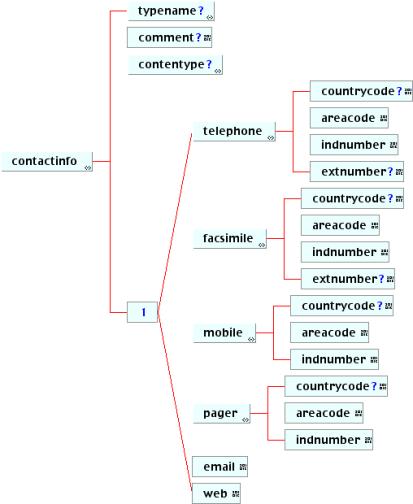
Figure 3.7 <contactinfo> elements.
Multiplicity: Occurs zero or more times within the <identification> element.
Attributes: None.
Elements:
Example:
<contactinfo>
<typename>
<tysource sourcetype="imsdefault"/>
<tyvalue>Private</tyvalue>
</typename>
<contentype>
<referential>
<indexid>contactinfo_01</indexid>
</referential>
</contentype>
<telephone>
<countrycode>44</countrycode>
<areacode>020</areacode>
<indnumber>6472239</indnumber>
</telephone>
</contactinfo>
Description: This element presents the default vocabulary that is made available to identify the type of contact information. If the standard vocabulary is insufficient then an alternative entry must be used through the <tysource> element.
Multiplicity: Occurs zero or once within the <contactinfo> element.
Attributes: None.
Description: This element contains the comments that are relevant to the contactinfo structure.
Multiplicity: Occurs zero or once within the <contactinfo> element.
Attributes:
Description: Contains the content meta-data description concerning the index for the data, access rights and time-stamps.
Multiplicity: Occurs zero or once within the <contactinfo> element.
Attributes: None.
Description: The telephone number.
Multiplicity: Occurs zero or once within the <contactinfo> element.
Attributes: None.
Elements:
Description: The facsimile number.
Multiplicity: Occurs zero or once within the <contactinfo> element.
Attributes: None.
Elements:
Description: The mobile telephone number.
Multiplicity: Occurs zero or once within the <contactinfo> element.
Attributes: None.
Elements:
Description: The pager number.
Multiplicity: Occurs zero or once within the <contactinfo> element.
Attributes: None.
Elements:
Description: The country code for the <telephone>, <facsimile>, <mobile> and <pager> elements. The entry is a string.
Multiplicity: Occurs zero or once within the <telephone>, <facsimile>, <mobile> and <pager> elements.
Attributes: None.
Description: The area code for the <telephone>, <facsimile>, <mobile> and <pager> elements. The entry is a string.
Multiplicity: Occurs once within the <telephone>, <facsimile>, <mobile> and <pager> elements.
Attributes: None.
Description: The number for the <telephone>, <facsimile>, <mobile> and <pager> elements. The entry is a string.
Multiplicity: Occurs once within the <telephone>, <facsimile>, <mobile> and <pager> elements.
Attributes: None.
Description: The extension number for the <telephone> and <facsimile> elements. The entry is a string.
Multiplicity: Occurs zero or once within the <telephone> and <facsimile> elements.
Attributes: None.
Description: An email address of the learner. The entry is a string.
Multiplicity: Occurs zero or once within the <contactinfo> element.
Attributes: None.
Description: A web address for the learner. The entry is a string.
Multiplicity: Occurs zero or once within the <contactinfo> element.
Attributes: None.
Description: The demographics element contains the information that is used to describe the type of learner e.g. gender, date of birth, etc.
Multiplicity: Occurs zero or more times within the <identification> element.
Attributes: None.
Elements:
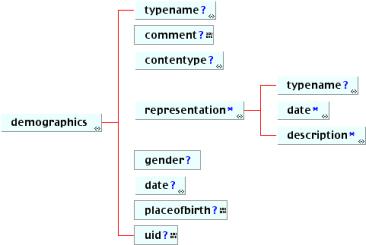
Figure 3.8 <demographics> elements.
Example:
<demographics>
<typename>
<tysource sourcetype="imsdefault"/>
<tyvalue>Adult</tyvalue>
</typename>
<contentype>
<referential>
<indexid>demographics_01</indexid>
</referential>
</contentype>
<representation>
<typename>
<tysource sourcetype="imsdefault"/>
<tyvalue>Photo</tyvalue>
</typename>
<description>
<full>
<media mediamode="Image"encoding="uri">learnerid/photo.gif</media>
</full>
</description>
</representation>
<gender gender="Male"/>
<date>
<typename>
<tysource sourcetype="imsdefault"/>
<tyvalue>Birth</tyvalue>
</typename>
<datetime>1901:04:01</datetime>
</date>
<placeofbirth>Texas</placeofbirth>
</demographics>
Description: This element presents the default vocabulary that is made available to identify the type of demographics information. If the standard vocabulary is insufficient then an alternative entry must be used through the <tysource> element.
Multiplicity: Occurs zero or once within the <demographics> element.
Attributes: None.
Description: This element contains the comments that are relevant to the demographics structure.
Multiplicity: Occurs zero or once within the <demographics> element.
Attributes:
Description: Contains the content meta-data description concerning the index for the data, access rights and time-stamps.
Multiplicity: Occurs zero or once within the <demographics> element.
Attributes: None.
Description: The representation of the learner e.g. their photograph, voice print, etc.
Multiplicity: Occurs zero or more times within the <demographics> element.
Attributes: None.
Elements:
Description: This element presents the default vocabulary that is made available to identify the type of representation information. If the standard vocabulary is insufficient then an alternative entry must be used through the <tysource> element.
Multiplicity: Occurs zero or once within the <representation> element.
Attributes: None.
Description: The store for significant dates relevant to the <demographics> and <representation> information.
Multiplicity: Occurs zero or once within the <demographics> and <representation> elements.
Attributes: None.
Description: Contains the content materials that are used to describe the demographics listed in the associated data.
Multiplicity: Occurs zero or once within the <demographics> element.
Attributes: None.
Description: Contains the place of birth of the learner - the granularity of the information is usage dependent.
Multiplicity: Occurs zero or once within the <demographics> element.
Attributes:
Description: Contains the place of birth of the learner - the granularity of the information is usage dependent. The entry format is a string.
Multiplicity: Occurs zero or once within the <demographics> element.
Attributes:
Description: Contains a user identifier for the learner e.g. social security number. The entry format is a string.
Multiplicity: Occurs zero or once within the <demographics> element.
Attributes: None.
Description: The agent element is used to contain the information that describes the ways in which an individual or organisations can act as representatives for the learner. The agents could be a parent, guardian, etc. and the roles they undertake could be aide, legal, medical, etc.
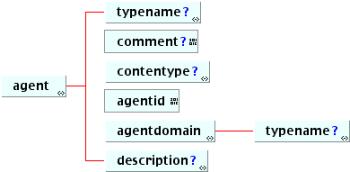
Multiplicity: Occurs zero or more times within the <identification> element.
Attributes: None.
Elements:
Example:
<agent>
<typename>
<tysource sourcetype="imsdefault"/>
<tyvalue>Tutor</tyvalue>
</typename>
<contentype>
<referential>
<indexid>agent_01</indexid>
</referential>
</contentype>
<agentid>Dr.Wason</agentid>
<agentdomain>
<typename>
<tysource sourcetype="imsdefault"/>
<tyvalue>Educational</tyvalue>
</typename>
</agentdomain>
<description>
<short>Course tutor</short>
</description>
</agent>
Description: This element presents the default vocabulary that is made available to identify the type of agent information. If the standard vocabulary is insufficient then an alternative entry must be used through the <tysource> element.
Multiplicity: Occurs zero or once within the <identification> element.
Attributes: None.
Description: This element contains the comments that are relevant to the agent structure.
Multiplicity: Occurs zero or once within the <agent> element.
Attributes:
Description: Contains the content meta-data description concerning the index for the data, access rights, time-stamps and IMS Meta-data.
Multiplicity: Occurs zero or once within the <agent> element.
Attributes: None.
Description: The identifier for the agent. The entry format is a string.
Multiplicity: Occurs once within the <agent> element.
Attributes: None.
Description: The role that the agent undertakes on behalf of the learner.
Multiplicity: Occurs once within the <agent> element.
Attributes: None.
Elements:
Description: This element presents the default vocabulary that is made available to identify the type of agent domain information. If the standard vocabulary is insufficient then an alternative entry must be used through the <tysource> element.
Multiplicity: Occurs zero or once within the <agentdomain> element.
Attributes: None.
Description: Contains the content materials that are used to describe the agent listed in the associated data.
Multiplicity: Occurs zero or once within the <agent> element.
Attributes: None.
Description: This element contains the proprietary extensions to the <identification> element.
Multiplicity: Occurs zero or once within the <identification> element.
Attributes: None
Description. The goal learner information consists of the description of the personal objectives and aspirations. These descriptions may also include information for monitoring the progress in achieving the goals. A goal can be defined in terms of sub-goals. A different ‘goal’ structure will be used for each entry.
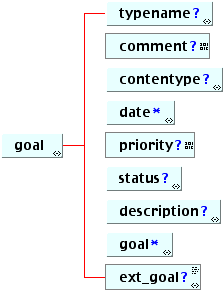
Multiplicity: Occurs zero or more within the <learnerinformation> element.
Attributes: None.
Elements:
Example:
<goal>
<typename>
<tysource sourcetype="imsdefault"/>
<tyvalue>Education</tyvalue>
</typename>
<contentype>
<referential>
<indexid>goal_01</indexid>
</referential>
</contentype>
<priority>Primary</priority>
<description>
<short>The primary goal.<short>
<description>
<goal>
<typename>
<tysource sourcetype="imsdefault"/>
<tyvalue>Education</tyvalue>
</typename>
<contentype>
<referential>
<indexid>goal_01_subgoal_01</indexid>
</referential>
</contentype>
<description>
<short>The first sub-goal of the primary goal.<short>
<description>
</goal>
</goal>
Description: This element presents the default vocabulary that is made available to identify the type of goal information. If the standard vocabulary is insufficient then an alternative entry must be used through the <tysource> element.
Multiplicity: Occurs zero or once within the <goal> element.
Attributes: None.
Description: This element contains the comments that are relevant to the goal structure.
Multiplicity: Occurs zero or once within the <goal> element.
Attributes:
Description: Contains the content meta-data description concerning the index for the data, access rights and time-stamps.
Multiplicity: Occurs zero or once within the <goal> element.
Attributes: None.
Description: The store significant dates relevant to the goal e.g. date of creation, target date for completion, etc. Each goal will tend to have several relevant dates.
Multiplicity: Occurs once or many times within the <goal> element.
Attributes: None.
Description: A goal may have a priority assigned to it. This priority can be used to show the relevance importance between goals defined at the same level of the hierarchy. Each goal can have a single priority.
Multiplicity: Occurs zero or once within the <goal> element.
Attributes:
Description: A goal can have an associated status e.g. Active, Complete, etc. A goal may have more than one status depending on the aims and objectives of the goal.
Multiplicity: Occurs zero or once within the <goal> element.
Attributes: None.
Description: Contains the content materials that are used to describe the goals presented in the associated data.
Multiplicity: Occurs zero or once within the <goal> element.
Attributes: None.
Description: This structure allows a goal to have sub-goals and in turn those sub-goals can have sub-goals. This allows the construction of hierarchically related goals.
Multiplicity: Occurs once or many times within the <goal> element.
Attributes: None.
Description: This element contains the proprietary extensions to the <goal> element.
Multiplicity: Occurs zero or once within the <goal> element.
Attributes: None.
Description: The qcl learner information consists of the qualifications, certifications and licenses awarded to the learner i.e. the formally recognised products of their learning and work history. This includes information on the awarding body and may also include electronic copies of the actual documents. A different ‘qcl’ structure will be used for each qualification, etc.
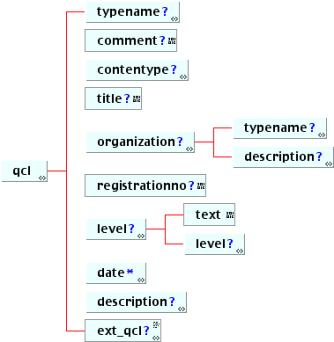
Multiplicity: Occurs zero or more within the <learnerinformation> element.
Attributes: None.
Elements:
Example:
<qcl>
<typename>
<tysource sourcetype="imsdefault"/>
<tyvalue>Qualification</tyvalue>
</typename>
<contentype>
<indexid>qcl_01</indexid>
</contentype>
<title>Microsoft Certified Engineer</title>
<organization>
<typename>
<tysource sourcetype="imsdefault"/>
<tyvalue>Training</tyvalue>
</typename>
<description>
<short>The Training Institute</short>
</description>
</organization>
<registrationno>35692348</registrationno>
<level>
<test>Trainer</text>
<date>
<typename>
<tysource sourcetype="imsdefault"/>
<tyvalue>Award</tyvalue>
</typename>
<datetime>2000:11:06</datetime>
</date>
</qcl>
Description: This element presents the default vocabulary that is made available to identify the type of QCL information. If the standard vocabulary is insufficient then an alternative entry must be used through the <tysource> element.
Multiplicity: Occurs zero or once within the <qcl> element.
Attributes: None.
Description: This element contains the comments that are relevant to the qcl structure.
Multiplicity: Occurs zero or once within the <qcl> element.
Attributes:
Description: Contains the content meta-data description concerning the index for the data, access rights and time-stamps.
Multiplicity: Occurs zero or once within the <qcl> element.
Attributes: None.
Description: The title of the qualification, certification or licence. The title would normally be printed the paper version of the qcl.
Multiplicity: Occurs once (mandatory) within the <qcl> element.
Attributes:
Description: This is the name of the organisation responsible for awarding the qualification, certification or licence e.g. the name of the university, professional body, etc.
Multiplicity: Occurs zero or once within the <qcl> element.
Attributes: None.
Description: This is used to contain the reference number assigned to the qualification, certification or license. This number would normally be assigned by the awarding agency and would be used to uniquely identify the award. Entry format is a string.
Multiplicity: Occurs zero or once within the <qcl> element.
Attributes: None.
Description: This is a quantification of the level of the award e.g. First Class, Distinction, etc. The recursive definition allows the description of hierarchical levels.
Multiplicity: Occurs zero or once within the <qcl> element.
Attributes: None.
Elements:
Description: This is a quantification of the level of the award e.g. First Class, Distinction, etc. The recursive definition allows the description of hierarchical levels.
Multiplicity: Occurs zero or once within the <level> element.
Attributes: None.
Description: This is the text containing the level of the award itself. The entry is contained as a ‘string’.
Multiplicity: Occurs once within the <level> element.
Attributes:
Description: The store significant dates relevant to the qcl e.g. date of attainment, date of expiry, etc. Each qcl will typically have several relevant dates.
Multiplicity: Occurs once or many times within the <qcl> element.
Attributes: None.
Description: Contains the content materials that are used to describe the qualification, certification or licence presented in the associated data.
Multiplicity: Occurs zero or once within the <qcl> element.
Attributes: None.
Description: This element contains the proprietary extensions to the <qcl> element.
Multiplicity: Occurs zero or once within the <qcl> element.
Attributes: None.
Description. The activity learner information consists of the education/training, work and service (military, community, voluntary, etc.) record and products (excluding formal awards). This information may include the descriptions of the courses undertaken and the records of the corresponding assessment. A separate ‘activity’ structure will be used for each entry.
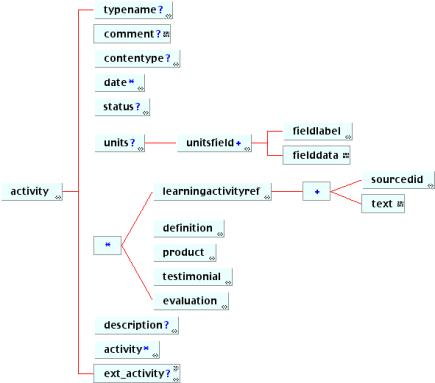
Figure 3.12 <activity> elements.
Multiplicity: Occurs zero or more within the <learnerinformation> element.
Attributes: None.
Elements:
Example:
<activity>
<typename>
<tysource sourcetype="imsdefault"/>
<tyvalue>Education</tyvalue>
</typename>
<contentype>
<referential>
<indexid>activity_01</indexid>
</referential>
</contentype>
<date>
<typename>
<tysource sourcetype="imsdefault"/>
<tyvalue>Finish</tyvalue>
</typename>
<datetime>2000:11:06</datetime>
</date>
<status>
<typename>
<tysource sourcetype="imsdefault"/>
<tyvalue>Complete</tyvalue>
</typename>
</status>
<units>
<unitsfield>
<fieldlabel>
<typename><tyvalue>credits</tyvalue></typename>
</fieldlabel>
<fielddata>2</fielddata>
</unitsfield>
</units>
<description>
<short>Credit assignment for the course</short>
</description>
</activity>
Description: This element presents the default vocabulary that is made available to identify the type of activity information. If the standard vocabulary is insufficient then an alternative entry must be used through the <tysource> element.
Multiplicity: Occurs zero or once within the <activity> element.
Attributes: None.
Description: This element contains the comments that are relevant to the activity structure.
Multiplicity: Occurs zero or once within the <activity> element.
Attributes:
Description: Contains the content meta-data description concerning the index for the data, access rights and time-stamps.
Multiplicity: Occurs zero or once within the <activity> element.
Attributes: None.
Description: The store significant dates relevant to the activity e.g. date of attainment, date of expiry, etc. Each activity will tend to have several relevant dates.
Multiplicity: Occurs once or many times within the <activity> element.
Attributes: None.
Description: An activity can have an associated status e.g. Active, Complete, etc.
Multiplicity: Occurs zero or once within the <activity> element.
Attributes: None.
Description: The credits or other equivalent measures that are assigned to the evaluation.
Multiplicity: Occurs zero or once within the <activity> element.
Attributes: None.
Elements:
Description: The container for the quantification of the units assigned to this evaluation.
Multiplicity: Occurs zero or once within the <units> element.
Attributes: None.
Description: The vocabulary used to identify the type of unit.
Multiplicity: Occurs once within the <unitsfield> element.
Attributes: None.
Description: The actual value entry for the data field.
Multiplicity: Occurs once within the <unitsfield> element.
Attributes: None.
Description: An external reference to the learning activity being detailed. This reference could be used in several different contexts e.g. to provide the course description for an associated evaluation, to reference an external evaluation for included testimonial, etc.
Multiplicity: Occurs zero or more times within the <activity> element.
Attributes: None.
Elements:
Example:
<learneractivityref>
<sourcedid>
,source>IMS_LIP_V1p0_Example</source>
<id>course_101</id>
</sourcedid>
</learneractivityref>
Description: The globally unique sourcedid for the learning activity.
Multiplicity: Occurs once within the <learningactivityref> element.
Attributes: None.
Description: A text description of the learning activity being referenced.
Multiplicity: Occurs zero or once within the <learningactivityref> element.
Attributes:
Description: This element is used to store the description of the course materials that have been studied as part of the activity. A recursive structure is used and so complex course descriptions can be supported based upon an arbitrary number of sub-course structures.
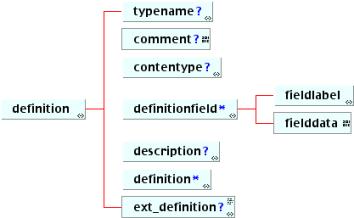
Figure 3.13 <definition> elements.
Multiplicity: Occurs zero or more times within the <activity> element.
Attributes: None.
Elements:
Example:
<definition>
<typename>
<tysource sourcetype="imsdefault"/>
<tyvalue>Course</tyvalue>
</typename>
<contentype>
<referential>
<indexid>definition_01</indexid>
</referential>
</contentype>
<definitionfield>
<fieldlabel>
<typename><tyvalue>Lecture_1</tyvalue></typename>
</fieldlabel>
<fielddata>Plant Structure</fielddata>
<definitionfield>
<definitionfield>
<fieldlabel>
<typename><tyvalue>Lecture_2</tyvalue></typename>
</fieldlabel>
<fielddata>Photosynthesis</fielddata>
<definitionfield>
<definitionfield>
<fieldlabel>
<typename><tyvalue>Lecture_3</tyvalue></typename>
</fieldlabel>
<fielddata>Plant Genetics</fielddata>
<definitionfield>
<description>
<short>A course on plant biology</short>
</description>
</definition>
Description: This element presents the default vocabulary that is made available to identify the type of definition information. If the standard vocabulary is insufficient then an alternative entry must be used through the <tysource> element.
Multiplicity: Occurs zero or once within the <definition> element.
Attributes: None.
Description: This element contains the comments that are relevant to the structure as a whole.
Multiplicity: Occurs zero or once within the <definition> element.
Attributes:
Description: Contains the content meta-data description concerning the index for the data, access rights and time-stamps.
Multiplicity: Occurs zero or once within the <definition> element.
Attributes: None.
Description: The container for the structure definition itself.
Multiplicity: Occurs zero or more times within the <definition> element.
Attributes: Nonne.
Description: The vocabulary used to identify the type of definition field.
Multiplicity: Occurs once within the <definitionfield> element.
Attributes: None.
Description: The actual value entry for the data field.
Multiplicity: Occurs once within the <definitionfield> element.
Attributes: None.
Description: Contains the content materials that are used to describe the definition listed in the associated data.
Multiplicity: Occurs zero or once within the <definition> element.
Attributes: None.
Description: This element contains the proprietary extensions to the <definition> element.
Multiplicity: Occurs zero or once within the <definition> element.
Attributes: None.
Description: The materials produced by the learner as a result of undertaking the activity. These materials can consist of any electronic storable information. The material stored should be that related to the activity only.
Multiplicity: Occurs zero or many times within the <activity> element.
Attributes: None.
Description: This element is used to contain the informal and formal comments made concerning the capabilities of the learner. A testimonial would, typically, be provided by a teacher, employer or someone who has a close knowledge of the relevant capabilities of the learner.
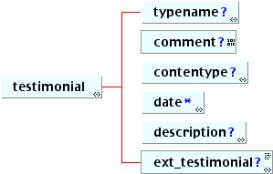
Figure 3.14 <testimonial> elements.
Multiplicity: Occurs zero or more times within the <activity> element.
Attributes: None.
Elements:
Example:
<testimonial>
<typename>
<tysource sourcetype="imsdefault"/>
<tyvalue>Academic</tyvalue>
</typename>
<contentype>
<referential>
<indexid>testimonial_01</indexid>
</referential>
</contentype>
<description>
<full>
<media mediamode="text" encoding="uri">student1/testimonial1.doc</media>
</full>
</description>
</testimonial>
Description: This element presents the default vocabulary that is made available to identify the type of testimonial information. If the standard vocabulary is insufficient then an alternative entry must be used through the <tysource> element.
Multiplicity: Occurs zero or once within the <testimonial> element.
Attributes: None.
Description: This element contains the comments that are relevant to the structure as a whole.
Multiplicity: Occurs zero or once within the <testimonial> element.
Attributes:
Description: Contains the content meta-data description concerning the index for the data, access rights and time-stamps.
Multiplicity: Occurs zero or once within the <testimonial> element.
Attributes: None.
Description: The store for significant dates relevant to the testimonial e.g. Recorded, etc. Each testimonial will tend to have several relevant dates.
Multiplicity: Occurs once or many times within the <testimonial> element.
Attributes: None.
Description: Contains the content materials that are used to describe the testimonial listed in the associated data.
Multiplicity: Occurs zero or once within the <testimonial> element.
Attributes: None.
Description: This element contains the proprietary extensions to the <testimonial> element.
Multiplicity: Occurs zero or once within the <testimonial> element.
Attributes: None.
Description: This element is used to store the summary results information produced by an evaluation of the learner’s activities. This evaluation could take the form of a viva, a written examination, etc. This structure is capable of supporting the summary results that would be obtained from an examination based upon the IMS QTI specification.
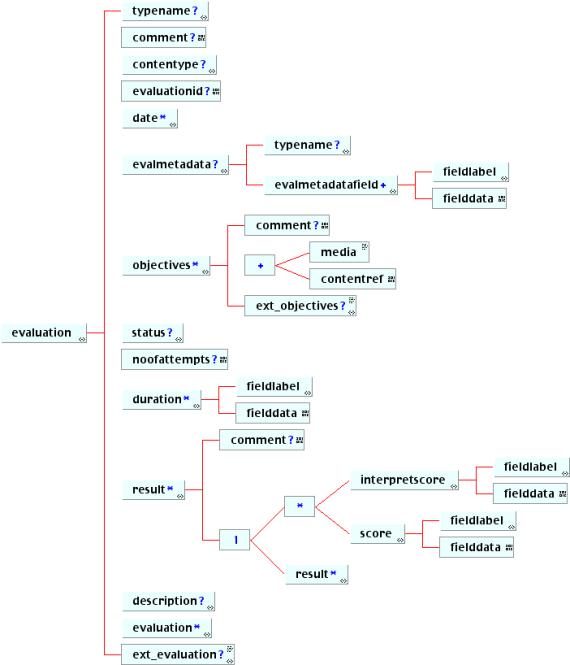
Figure 3.15 <evaluation> elements.
Multiplicity: Occurs zero or more times within the <activity> element.
Attributes: None.
Elements:
Example:
<evaluation>
<typename>
<tysource sourcetype="imsdefault"/>
<tyvalue>QTI_Assessment</tyvalue>
</typename>
<contentype>
<referential>
<sourcedid>
<source>TOEFL</source>
<id>12345</id>
</soucedid>
</referential>
</contentype>
<evaluationid>QTI_Assessment_IDLabel</evaluationid>
<noofattempts>3</noofattempts>
<result>
<interpretscore>
<fieldlabel><typename><tyvalue>Minimum score</tyvalue></typename></fieldlabel>
<fieldata>0</fielddata>
</interpretscore>
<interpretscore>
<fieldlabel><typename><tyvalue>Maximum score</tyvalue></typename></fieldlabel>
<fieldata>100</fielddata>
</interpretscore>
<score>
<fieldlabel><typename><tyvalue>Score</tyvalue></typename></fieldlabel>
<fieldata>30</fielddata>
</score>
</result>
</evaluation
Description: This element presents the default vocabulary that is made available to identify the type of evaluation information. If the standard vocabulary is insufficient then an alternative entry must be used through the <tysource> element.
Multiplicity: Occurs zero or once within the <evaluation> element.
Attributes: None.
Description: This element contains the comments that are relevant to the structure as a whole.
Multiplicity: Occurs zero or once within the <evaluation> element.
Attributes:
Description: Contains the content meta-data description concerning the index for the data, access rights and time-stamps.
Multiplicity: Occurs zero or once within the <evaluation> element.
Attributes: None.
Description: The identifier assigned to the evaluation. In the case of IMS QTI this equates to the identifier assigned to the relevant ASI component.
Multiplicity: Occurs zero or once within the <evaluation> element.
Attributes: None.
Description: The store for significant dates relevant to the evaluation e.g. Taken, etc. Each evaluation will tend to have several relevant dates.
Multiplicity: Occurs once or many times within the <evaluation> element.
Attributes: None.
Description: The groups of meta-data that is directly associated with the evaluation mechanism. In the case of IMS QTI ASI components this will be used to store the corresponding ASI meta-data.
Multiplicity: Occurs zero or once within the <evaluation> element.
Attributes: None.
Elements:
Description: The meta-data that is directly associated with the evaluation mechanism. Each of these elements contains a single meta-data field.
Multiplicity: Occurs once or many times within the <evalmetadata> element.
Attributes: None.
Elements:
Description: The objectives associated with the evaluation.
Multiplicity: Occurs zero or more times within the <evaluation> element. Each view may be assigned its own set of objectives.
Attributes:
Elements:
Description: The actual objectives themselves. The data is stored as ‘base-64’ coding.
Multiplicity: Occurs zero or more times within the <objectives> element.
Attributes:
Description: The external reference label for the objectives material. This external reference takes the form as described in the IMS QTI specification for the ‘matref’ element. The entry format is a string.
Multiplicity: Occurs zero or more times within the <objectives> element.
Attributes: None.
Description: An evaluation can have an associated status e.g. Active, Complete, etc.
Multiplicity: Occurs zero or once within the <evaluation> element.
Attributes: None.
Description: The number of attempts undertaken in completing the evaluation. The entry format is an integer.
Multiplicity: Occurs zero or once within the <evaluation> element.
Attributes: None.
Description: Contains information that describes time-based statistics about the evaluation e.g. time taken to complete the evaluation, average time taken per attempt, etc.
Multiplicity: Occurs zero or more times within the <evaluation> element.
Attributes: None.
Elements:
Description: Contains the summary results concerning the evaluation itself. These results concern the actual scores and the associated context information for their interpretation.
Multiplicity: Occurs zero or more times within the <evaluation> element.
Attributes: None.
Elements:
Description: Contains interpretative information about the scores to be recorded e.g. the maximum possible score of the exam.
Multiplicity: Occurs zero or more times within the <result> element.
Attributes: None.
Elements:
Description: Contains the actual values of the relevant results e.g. the score of the exam.
Multiplicity: Occurs zero or more times within the <result> element.
Attributes: None.
Elements:
Description: The vocabulary used to identify the type of <duration>, <interpretscore> or <score> fields.
Multiplicity: Occurs once within the <duration>, <interpretscore> and <score> elements.
Attributes: None.
Description: The actual value entry for the data field.
Multiplicity: Occurs once within the <duration>, <interpretscore> and <score> elements.
Attributes: None.
Description: Contains the content materials that are used to describe the evaluation listed in the associated data.
Multiplicity: Occurs zero or once within the <evaluation> element.
Attributes: None.
Description: This recursive structure allows complex summary results information to be stored. An evaluation may itself be defined in terms of the sub-evaluations.
Multiplicity: Occurs zero or more times within the <evaluation> element.
Attributes: None.
Description: This element contains the proprietary extensions to the <evaluation> element.
Multiplicity: Occurs zero or once within the <evaluation> element.
Attributes: None.
Description: Contains the content materials that are used to describe the activity listed in the associated data.
Multiplicity: Occurs zero or once within the <activity> element.
Attributes: None.
Description: This element contains the proprietary extensions to the <activity> element.
Multiplicity: Occurs zero or once within the <activity> element.
Attributes: None.
Description. The competency learner information consists of the descriptions of the skills the learner has acquired. These skills may be associated with some formal or informal training or work history (described in the ‘activity’) and formal awards (described in the ‘qcl’). The corresponding level of competency may also be defined. A different ‘competency’ structure will be used for each competency.
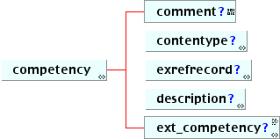
Figure 3.16 <competency> elements.
Multiplicity: Occurs zero or more times within the <learnerinformation> element.
Attributes. None.
Elements:
Example:
<competency>
<contentype>
<referential>
<indexid>competency_01</indexid>
</referential>
</contentype>
<exrefrecord>
<date>
<typename>
<tysource sourcetype="imsdefault"/>
<tyvalue>Awarded</tyvalue>
</typename>
<datetime>1999:10:31</datetime>
</date>
<recformat uri="formats/pcsupport.doc"/>
<recdata uri="studentname/competency.doc"/>
</exrefrecord>
<description>
<short>Level 1 Hardware Support for PCs<short>
</description>
</competency>
Description: This element contains the comments that are relevant to the structure as a whole.
Multiplicity: Occurs zero or once within the <competency> element.
Attributes:
Description: Contains the content meta-data description concerning the index for the data, access rights and time-stamps.
Multiplicity: Occurs zero or once within the <competency> element.
Attributes: None.
Description: The actual competency information is contained within this element. Either a reference to an external file is used or the content is supplied directly in a format appropriate to the competency description itself.
Multiplicity: Occurs zero or once within the <competency> element.
Attributes: None.
Description: Contains the content materials that are used to describe the competencies listed in the associated data.
Multiplicity: Occurs zero or once within the <competency> element.
Attributes: None.
Description: This element contains the proprietary extensions to the <competency> element.
Multiplicity: Occurs zero or once within the <competency> element.
Attributes: None.
Description. The transcript learner information is used to store the summary records of the academic performance at an institution. This information may contain an arbitrary level of detail and so there is no proscribed structure for a transcript. A separate entry is used for each transcript record.
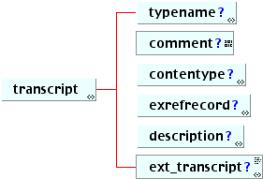
Figure 3.17 <transcript> elements.
Multiplicity: Occurs zero or more times within the <learnerinformation> element.
Attributes: None.
Elements:
<transcript>
<contentype>
<referential>
<indexid>transcript_01</indexid>
</referential>
</contentype>
<exrefrecord>
<date>
<typename>
<tysource sourcetype="imsdefault"/>
<tyvalue>Awarded</tyvalue>
</typename>
<datetime>2000:02:18</datetime>
</date>
<recformat uri="transformats/schools.doc"/>
<recdata uri="student234/hstranscript.doc"/>
</exrefrecord>
<description>
<short>External reference to a High-school transcript.</short>
</description>
</transcript>
Description: This element presents the default vocabulary that is made available to identify the type of transcript information. If the standard vocabulary is insufficient then an alternative entry must be used through the <tysource> element.
Multiplicity: Occurs zero or once within the <transcript> element.
Attributes: None.
Description: This element contains the comments that are relevant to the structure as a whole.
Multiplicity: Occurs zero or once within the <transcript> element.
Attributes:
Description: Contains the content meta-data description concerning the index for the data, access rights and time-stamps.
Multiplicity: Occurs zero or once within the <transcript> element.
Attributes: None.
Description: The actual transcript information is contained within this element. Either a reference to an external file is used or the content is supplied directly in a format appropriate to the transcript description itself.
Multiplicity: Occurs zero or once within the <transcript> element.
Attributes: None.
Description: Contains the content materials that are used to describe the transcript listed in the associated data.
Multiplicity: Occurs zero or once within the <transcript> element.
Attributes: None.
Description: This element contains the proprietary extensions to the <transcript> element.
Multiplicity: Occurs zero or once within the <transcript> element.
Attributes: None.
Description. The accessibility learner information consists of the cognitive, technical and physical preferences for the learner, disability, eligibility and language capabilities. These describe the learner’s capabilities to interact with the learning environment.
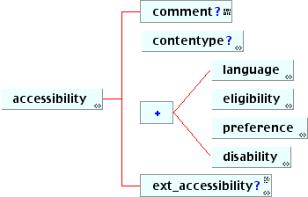
Figure 3.18 <accessibility> elements.
Multiplicity: Occurs zero or more times within the <learnerinformation> element.
Attributes: None.
Elements:
Description: This element contains the comments that are relevant to the structure as a whole.
Multiplicity: Occurs zero or once within the <accessibility> element.
Attributes:
Description: Contains the content meta-data description concerning the index for the data, access rights and time-stamp.
Multiplicity: Occurs zero or once within the <accessibility> element.
Attributes: None.
Description. Contains the information that describes the language proficiencies of the learner. The language proficiencies refer to the oral, written and reading abilities of the learner.
Multiplicity: Occurs zero or more times within the <accessibility> element.
Attributes: None.

Figure 3.19 <language> elements.
Elements:
Example:
<language>
<typename>
<tysource sourcetype="imsdefault"/>
<tyvalue>French</tyvalue>
</typename>
<contentype>
<referential>
<indexid>language_01</indexid>
</referential>
</contentype>
<proficiency profcode="OralSpeak">Excellent</proficiency>
<proficiency profcode="OralComp">Excellent</proficiency>
<proficiency profcode="Read">Good</proficiency>
<proficiency profcode="Write">Poor</proficiency>
</language>
Description: This element presents the default vocabulary that is made available to identify the type of language information. If the standard vocabulary is insufficient then an alternative entry must be used through the <tysource> element.
Multiplicity: Occurs zero or once within the <testimonial> element.
Attributes: None.
Description: This element contains the comments that are relevant to the structure as a whole.
Multiplicity: Occurs zero or once within the <language> element.
Attributes:
Description: Contains the content meta-data description concerning the index for the data, access rights and time-stamps.
Multiplicity: Occurs zero or once within the <language> element.
Attributes: None.
Description: Contains the description of the oral, writing and reading proficiencies for a particular language. Each proficiency entry can be used to describe all the capabilities for one particular language. Different languages should be submitted under separate <language> entries.
Multiplicity: Occurs zero or many times within the <language> element.
Attributes:
Description: This element contains the proprietary extensions to the <language> element.
Multiplicity: Occurs zero or once within the <language> element.
Attributes: None.
Description: In many situations learners have a set of preferences for how they interact with a learning system. These preferences can be used to describe the physical environment required, the input/output technology required and also the learning styles that best suit the individual.
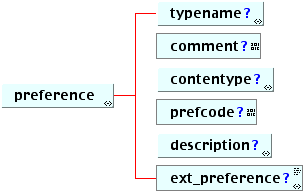
Figure 3.20 <preference> elements.
Multiplicity: Occurs zero or more times within the <accessibility> element.
Attributes: None.
Elements:
Example:
<preference>
<typename>
<tysource sourcetype="imsdefault"/>
<tyvalue>Physical</tyvalue>
</typename>
<contentype>
<referential>
<indexid>preference_01</indexid>
</referential>
</contentype>
<prefcode>Learning centre access</prefcode>
</preference>
Description: This element presents the default vocabulary that is made available to identify the type of preference information. If the standard vocabulary is insufficient then an alternative entry must be used through the <tysource> element.
Multiplicity: Occurs zero or once within the <testimonial> element.
Attributes: None.
Description: This element contains the comments that are relevant to the structure as a whole.
Multiplicity: Occurs zero or once within the <preference> element.
Attributes:
Description: Contains the content meta-data description concerning the index for the data, access rights and time-stamps.
Multiplicity: Occurs zero or once within the <preference> element.
Attributes: None.
Description: The description of the preference itself. This could take the form of an agreed coding mechanism or a simple text based description. The entry format is as a string.
Multiplicity: Occurs zero or once within the <preference> element.
Attributes:
Description: Contains the content materials that are used to describe the preferences listed in the associated data.
Multiplicity: Occurs zero or once within the <preference> element.
Attributes: None.
Description: This element contains the proprietary extensions to the <preference> element.
Multiplicity: Occurs zero or once within the <preference> element.
Attributes: None.
Description: There may be many criteria that must be applied to the learner to determine their eligibility for types of support, activity, etc. Typical areas of eligibility are financial support and study prerequisites. At present this data structure is incomplete and will be developed in further releases of the LIP specification.
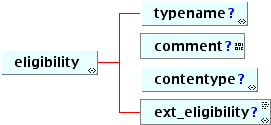
Figure 3.21 <eligibility> elements.
Multiplicity: Occurs zero or more times within the <accessibility> element.
Attributes: None.
Elements:
Note This element is for further study in later releases of this specification.
Description: This element presents the default vocabulary that is made available to identify the type of eligibility information. If the standard vocabulary is insufficient then an alternative entry must be used through the <tysource> element.
Multiplicity: Occurs zero or once within the <testimonial> element.
Attributes: None.
Description: This element contains the comments that are relevant to the structure as a whole.
Multiplicity: Occurs zero or once within the <eligibility> element.
Attributes:
Description: Contains the content meta-data description concerning the index for the data, access rights and time-stamps.
Multiplicity: Occurs zero or once within the <eligibility> element.
Attributes: None.
Description: This element contains the proprietary extensions to the <eligibility> element.
Multiplicity: Occurs zero or once within the <eligibility> element.
Attributes: None.
Description: The disabilities suffered by the individual should be recorded if these will have an effect on the learner’s ability to learn e.g. poor eyesight may require the usage of larger fonts. At present this data structure is incomplete and will be developed in further releases of the LIP specification.
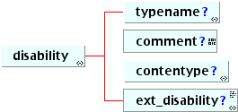
Figure 3.22 <disability> elements.
Multiplicity: Occurs zero or more times within the <accessibility> element.
Attributes: None.
Elements:
Note: This element is for further study in later releases of this specification.
Description: This element presents the default vocabulary that is made available to identify the type of disability information. If the standard vocabulary is insufficient then an alternative entry must be used through the <tysource> element.
Multiplicity: Occurs zero or once within the <testimonial> element.
Attributes: None.
Description: This element contains the comments that are relevant to the structure as a whole.
Multiplicity: Occurs zero or once within the <disability> element.
Attributes:
Description: Contains the content meta-data description concerning the index for the data, access rights and time-stamps.
Multiplicity: Occurs zero or once within the <disability> element.
Attributes: None.
Description: This element contains the proprietary extensions to the <disability> element.
Multiplicity: Occurs zero or once within the <disability> element.
Attributes: None.
Description: This element contains the proprietary extensions to the <accessibility> element.
Multiplicity: Occurs zero or once within the <accessibility> element.
Attributes: None.
Description: The interest learner information consists of descriptions of the hobbies and other recreation activities. These interests may have formal awards (as described in the associated ‘qcl’). Electronic versions of the products of these interests may also be contained. Each interest will be described within its own structure.
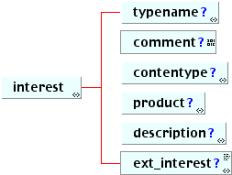
Figure 3.23 <interest> elements.
Multiplicity: Occurs zero or more times within the <learnerinformation> element.
Attributes: None.
Elements:
<interest>
<typename>
<tysource sourcetype="imsdefault"/>
<tyvalue>Recreational</tyvalue>
</typename>
<contentype>
<referential>
<indexid>interest_01</indexid>
</referential>
</contentype>
<product>
<typename>
<tysource sourcetype="imsdefault"/>
<tyvalue>Portfolio</tyvalue>
</typename>
<contentype>
<referential>
<indexid>product_01</indexid>
</referential>
</contentype>
<description>
<full>
<media mediamode="Image" encoding="uri">personal/picture.gif</media>
<full>
</description>
</product>
<description>
Short>An amateur water-colour artist<short>
</description>
</interest>
Description: This element presents the default vocabulary that is made available to identify the type of interest information. If the standard vocabulary is insufficient then an alternative entry must be used through the <tysource> element.
Multiplicity: Occurs zero or once within the <interest> element.
Attributes: None.
Description: This element contains the comments that are relevant to the structure as a whole.
Multiplicity: Occurs zero or once within the <interest> element.
Attributes:
Description: Contains the content meta-data description concerning the index for the data, access rights and time-stamps.
Multiplicity: Occurs zero or once within the <interest> element.
Attributes: None.
Description: The materials that have been created by the learner and which constitute a part of the interest itself e.g. this could include a picture of the garden from a gardener.
Multiplicity: Occurs zero or once within the <interest> element.
Attributes: None.
Description: Contains the content materials that are used to describe the interests presented in the associated data.
Multiplicity: Occurs zero or once within the <interest> element.
Attributes: None.
Description: This element contains the proprietary extensions to the <interest> element.
Multiplicity: Occurs zero or once within the <interest> element.
Attributes: None.
Description: The affiliation learner information is used to store the descriptions of the organisation affiliations associated with the learner. These affiliations are intended to consist of those of a professional, personal, military or civic nature. Membership of groups and activities within the work environment should be supported using the IMS Enterprise specification.
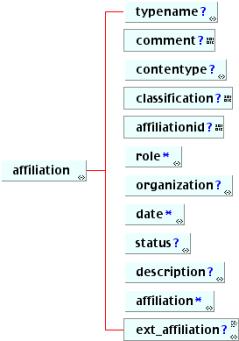
Figure 3.24 <affiliation> elements.
Multiplicity: Occurs zero or more times within the <learnerinformation> element.
Attributes: None.
Elements:
<affiliation>
<typename>
<tysource sourcetype="imsdefault"/>
<tyvalue>Professional</tyvalue>
</typename>
<contentype>
<referential>
<indexid>affiliation_01</indexid>
</referential>
</contentype>
<affiliationid>2457923A</affiliationid>
<organization>
<typename>
<tysource sourcetype="imsdefault"/>
<tyvalue>Professional</tyvalue>
</typename>
<description>
<short>Institute of Electronic & Electrical Engineers</short>
</description>
</organization>
<date>
<typename>
<tysource sourcetype="imsdefault"/>
<tyvalue>Join</tyvalue>
</typename>
<datetime>1998</datetime>
</date>
<status>
<typename>
<tysource sourcetype="imsdefault"/>
<tyvalue>Active</tyvalue>
</typename>
</status>
<description>
<short>All fees paid</short>
</description>
</affiliation>
Description: This element presents the default vocabulary that is made available to identify the type of affiliation information. If the standard vocabulary is insufficient then an alternative entry must be used through the <tysource> element.
Multiplicity: Occurs zero or once within the <affiliation> element.
Attributes: None.
Description: This element contains the comments that are relevant to the structure as a whole.
Multiplicity: Occurs zero or once within the <affiliation> element.
Attributes:
Description: Contains the content meta-data description concerning the index for the data, access rights and time-stamps.
Multiplicity: Occurs zero or once within the <affiliation> element.
Attributes: None.
Description: Contains the class of the affiliation e.g. executive, honorary, etc.
Multiplicity: Occurs zero or once within the <affiliation> element.
Attributes:
Description: This is used to store the identification number of the affiliation e.g. the membership number assigned to the learner for that particular organisation. This number would normally be assigned by the organisation itself. Entry format is a string.
Multiplicity: Occurs zero or once within the <affiliation> element.
Attributes: None.
Description: A learner will have roles in the organisations to which they are affiliated. These roles will change over time and together they form an important part of a resume.
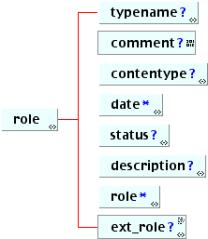
Multiplicity: Occurs once or many times within the <affiliation> element.
Attributes: None.
Elements:
Example:
<role>
<typename>
<tysource sourcetype="imsdefault"/>
<tyvalue>Officer</tyvalue>
</typename>
<contentype>
<referential>
<indexid>affiliation_role_01</indexid>
</referential>
</contentype>
<date>
<typename>
<tysource sourcetype="imsdefault"/>
<tyvalue>Start</tyvalue>
</typename>
<datetime>2000:04:01</datetime>
</date>
<date>
<typename>
<tysource sourcetype="imsdefault"/>
<tyvalue>Finish</tyvalue>
</typename>
<datetime>2001:03:31</datetime>
</date>
<description>
<short>Region 8</short>
</description>
</role>
Description: This element presents the default vocabulary that is made available to identify the type of role information. If the standard vocabulary is insufficient then an alternative entry must be used through the <tysource> element.
Multiplicity: Occurs zero or once within the <role> element.
Attributes: None.
Description: This element contains the comments that are relevant to the structure as a whole.
Multiplicity: Occurs zero or once within the <role> element.
Attributes:
Description: Contains the content meta-data description concerning the index for the data, access rights and time-stamps.
Multiplicity: Occurs zero or once within the <role> element.
Attributes: None.
Description: The store for significant dates relevant to the role e.g. start, finish, etc. Each role will tend to have several relevant dates.
Multiplicity: Occurs once or many times within the <affiliation> element.
Attributes: None.
Description: A role will have an associated status e.g. Active, Pending, Retired, etc.
Multiplicity: Occurs zero or once within the <role> element.
Attributes: None.
Description: Contains the content materials that are used to describe the role listed in the associated data.
Multiplicity: Occurs zero or once within the <role> element.
Attributes: None.
Description: The role within an organisation could consist of one or more sub-roles. These sub-roles can themselves have sub-roles and so any complex hierarchy can be supported.
Multiplicity: Occurs zero or many times within the <role> element.
Attributes: None.
Description: This element contains the proprietary extensions to the <role> element.
Multiplicity: Occurs zero or once within the <role> element.
Attributes: None.
Description: This is the name of the organisation to which the learner is affiliated. If the user is affiliated to more than one organisation then this must be entered in different affiliations.
Multiplicity: Occurs zero or once within the <affiliation> element.
Attributes: None.
Description: The store for significant dates relevant to the affiliation e.g. joining date, date of expiry, etc. Each affiliation will tend to have several relevant dates.
Multiplicity: Occurs once or many times within the <affiliation> element.
Attributes: None.
Description: An affiliation can have an associated status e.g. Active, Pending, Retired, etc.
Multiplicity: Occurs zero or once within the <affiliation> element.
Attributes: None.
Description: Contains the content materials that are used to describe the affiliation listed in the associated data.
Multiplicity: Occurs zero or once within the <affiliation> element.
Attributes: None.
Description: This structure allows an affiliation to have sub-affiliations and in turn those affiliations can have sub-affiliations. This allows the construction of hierarchically related affiliations.
Multiplicity: Occurs once or many times within the <affiliation> element.
Attributes: None.
Description: This element contains the proprietary extensions to the <affiliation> element.
Multiplicity: Occurs zero or once within the <affiliation> element.
Attributes: None.
Description. The securitykey learner information is used to store the passwords and security codes that are to be used when communicating with the learner or are authorised/validated by the learner. A different ‘securitykey’ structure will be used for each key and class of key.
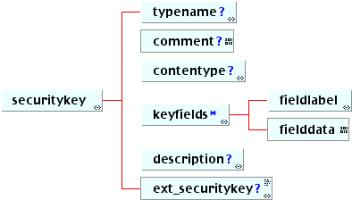
Figure 3.26 <securitykey> elements.
Multiplicity. Occurs zero or more times within the <learnerinformation> element.
Attributes. None.
Elements
<securitykey>
<typename>
<tysource sourcetype="imsdefault"/>
<tyvalue>Password</tyvalue>
</typename>
<contentype>
<referential>
<indexid>securitykey_01</indexid>
</referential>
</contentype>
<keyfields>
<fieldlabel>
<typename><tyvalue>userlmspassword</tyvalue></typename>
</fieldlabel>
<fielddata>nitwoodmgsbtsoy<fielddata>
</keyfields>
<description>
<short>User access password to the LMS</short>
</description>
</securitykey>
Description: This element presents the default vocabulary that is made available to identify the type of securitykey information. If the standard vocabulary is insufficient then an alternative entry must be used through the <tysource> element.
Multiplicity: Occurs zero or once within the <securitykey> element.
Attributes: None.
Description: This element contains the comments that are relevant to the structure as a whole.
Multiplicity: Occurs zero or once within the <securitykey> element.
Attributes:
Description: Contains the content meta-data description concerning the index for the data, access rights and time-stamps.
Multiplicity: Occurs zero or once within the <transcript> element.
Attributes: None.
Description: Each security key is contained as a tuple. This tuple defines the type of security key and the actual key itself. Each security key is contained within its own tuple but an arbitrary number of keys can be contained within the overall <securitykey> structure.
Multiplicity: Occurs zero or more times within the <securitykey> element.
Attributes: None.
Elements:
Description: The vocabulary used to identify the type of key.
Multiplicity: Occurs once within the <keyfields> element.
Attributes: None.
Description: The actual value entry for the data field.
Multiplicity: Occurs once within the <keyfields> element.
Attributes: None.
Description: Contains the content materials that are used to describe the security keys listed in the associated data.
Multiplicity: Occurs zero or once within the <securitykey> element.
Attributes: None.
Description: This element contains the proprietary extensions to the <securitykey> element.
Multiplicity: Occurs zero or once within the <securitykey> element.
Attributes: None.
Description. The relationship learner information is used to store the description of the relations between the other core data structures. All of the relationship information has been removed from the other structures to enable these to be collected at a single place.
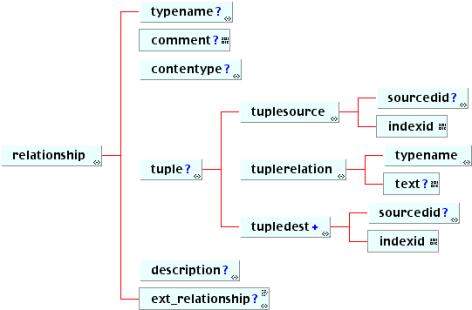
Figure 3.27 <relationship> elements.
Multiplicity. Occurs zero or more times within the <learnerinformation> element.
Attributes. None.
Elements:
<relationship>
<contentype>
<referential>
<indexid>relationship_01</indexid>
</referential>
</contentype>
<tuple>
<tuplesource>
</sourcedid>
<source>IMS_LIP_V1p0_Example</source>
<id>1001</id>
</sourcedid>
<indexid>qcl_01</indexid>
</tuplesource>
<tuplerelation>
<text>results_from</text>
</tuplerelation>
<tupledestination>
</sourcedid>
<source>IMS_LIP_V1p0_Example</source>
<id>1001</id>
</sourcedid>
<indexid>transcript_01</indexid>
</tupledestination>
</tuple>
<description>
<short>The detailed transcript for an awarded qualification</short>
</description>
</relationship>
Description: This element presents the default vocabulary that is made available to identify the type of relationship information. If the standard vocabulary is insufficient then an alternative entry must be used through the <tysource> element.
Multiplicity: Occurs zero or once within the <relationship> element.
Attributes: None.
Description: This element contains the comments that are relevant to the structure as a whole.
Multiplicity: Occurs zero or once within the <relationship> element.
Attributes:
Description: Contains the content meta-data description concerning the index for the data, access rights and time-stamps.
Multiplicity: Occurs zero or once within the <relationship> element.
Attributes: None.
Description: Contains the content materials that are used to describe the relationships listed in the associated data. The relationship is defined as a one to many relationship i.e. one source to many destinations using one relationship definition.
Multiplicity: Occurs zero or once within the <relationship> element.
Attributes: None.
Description: The source component of the relationship. There is only one source for the one or more destination components. The source is defined either by its <indexid> or by the combination of its <sourcedid> and <indexid>.
Multiplicity: Occurs once within the <tuple> element.
Attributes: None.
Description: The destination component of the relationship. There may be several destination components for each source. The destination is defined either by its <indexid> or by the combination of its <sourcedid> and <indexid>.
Multiplicity: Occurs once or more times within the <tuple> element.
Attributes: None.
Description: The relationship that is to be defined between the source and destination identifiers. The relationship is selected from a particular vocabulary.
Multiplicity: Occurs once within the <tuple> element.
Attributes: None.
Description: The <sourcedid> is a globally unique identifier assigned to the learner or the appropriate data object. The manner in which this identifier is generated is beyond the scope of this specification.
Multiplicity: Occurs zero or once within the <tuplesource> and <tupledest> elements.
Attributes: None.
Description: The <indexid> is a unique identifier for the data object. The identifier is unique with respect to the associated <sourcedid> allocated to the learner. This <indexid> is persistent in that all references to this same data object must use the same <indexid>.
Multiplicity: Occurs once within the <tuplesource> and <tupledest> elements.
Attributes: None.
Description: The mechanism by which the available tuplerelation type vocabulary is presented. This vocabulary is supplied through either an external file reference or by explicitly giving the required type.
Multiplicity: Occurs zero or once within the <tuplerelation> element.
Attributes: None.
Description: This is the text containing the definition of the relationship itself if a suitable form is not found in the <vocab> supplied vocabulary. The entry is contained as a ‘string’.
Multiplicity: Occurs zero or once within the <tuplerelation> element.
Attributes:
Description: Contains the content materials that are used to describe the relationships listed in the associated data.
Multiplicity: Occurs zero or once within the <relationship> element.
Attributes: None.
Description: This element contains the proprietary extensions to the <relationship> element.
Multiplicity: Occurs zero or once within the <relationship> element.
Attributes: None.
The common elements that are defined in this sub-section are:
Description: This element contains the comments that are relevant to the structure as a whole.
Attributes:
Elements: None.
Example:
<comment>A comment concerning the data object being defined</comment>
Description: The container for the control information that is used to describe the learner information. This information consists of: referential, temporal and privacy information and is applied to each of the ‘atomic’ parts of the learner information structure.
Attributes: None.
Elements:
Example:
<contentype>
<referential>
<indexid>indexnumber_01</indexid>
</referential>
<temporal>
<typename>
<tysource sourcetype="imsdefault"/>
<tyvalue>Creation</tyvalue>
</typename>
<temporalfield>
<fieldlabel><typename><tyvalue>CreateDateTime</tyvalue></typename>
</fieldlabel>
<fielddata>2000:11:06T09:00:00</fielddata>
</temporalfield>
</temporal>
<temporal>
<typename>
<tysource sourcetype="imsdefault"/>
<tyvalue>Expiry</tyvalue>
</typename>
<temporalfield>
<fieldlabel><typename><tyvalue>ExpireDateTime</tyvalue></typename>
</fieldlabel>
<fielddata>2001:10:31T08:59:59</fielddata>
</temporalfield>
</temporal>
<privacy>
<typename>
<tysource sourcetype="imsdefault"/>
<tyvalue>Owner</tyvalue>
</typename>
<privacyfield>
<fieldlabel><typename><tyvalue>Access Rights</tyvalue></typename>
</fieldlabel>
<fielddata>Create, Read, Update, Write</fielddata>
</privacyfield>
</privacy>
<privacy>
<typename>
<tysource sourcetype="imsdefault"/>
<tyvalue>Steward</tyvalue>
</typename>
<privacyfield>
<fieldlabel><typename><tyvalue>Access Rights</tyvalue></typename>
</fieldlabel>
<fielddata>Read, Write, Delete</fielddata>
</privacyfield>
</privacy>
</contentype
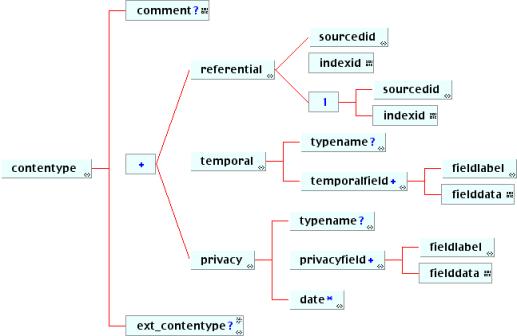
Figure 3.28 <contentype> elements.
Description: This element contains the comments that are relevant to the structure as a whole.
Multiplicity: Occurs zero or once within the <contentype> element.
Attributes:
Description: The referential information is used to uniquely identify the learner information record as a whole and the individual data components within that record. These enable each piece of information to be identified. The actual identification system is outside the scope of this specification.
Multiplicity: Occurs once or more times within the <contentype> element.
Attributes: None.
Elements:
Description: This information is used to describe any time-based dependencies of the data. This includes information such as the date of creation, time-stamp and expiry date of the learner information. The date/time descriptions are expected to conform to the ISO8601 standard.
Multiplicity: Occurs zero or more times within the <contentype> element.
Attributes: None.
Elements:
Description: This element presents the default vocabulary that is made available to identify the type of referential information. If the standard vocabulary is insufficient then an alternative entry must be used through the <tysource> element.
Multiplicity: Occurs zero or once within the <referential> element.
Attributes: None.
Description: The container for the quantification of the temporal data objects.
Multiplicity: Occurs once or more times within the <temporal> element.
Attributes: None.
Elements:
Description: All of the data relevant to the privacy, authenticity and integrity of the learner information is contained within this structure. The actual privacy etc. mechanism and architectures used to support the learner information are outside of the scope of the specification but they interact with the learner information through these structures.
Multiplicity: Occurs zero or more times within the <contentype> element.
Attributes: None.
Elements:
Description: This element presents the default vocabulary that is made available to identify the type of privacy information. If the standard vocabulary is insufficient then an alternative entry must be used through the <tysource> element.
Multiplicity: Occurs zero or once within the <privacy> element.
Attributes: None.
Description: The container for the quantification of the privacy data objects.
Multiplicity: Occurs once or more times within the <privacy> element.
Attributes: None.
Elements:
Description: This element contains the proprietary extensions to the <contentype> element.
Multiplicity: Occurs zero or once within the <contentype> element.
Attributes: None.
Description: Many of the data objects require the storage of the appropriate content, including brief descriptions of the nature of the material being stored or referenced. Three classification of description are supported and it is an implementation issue for how each of these classes are used and processed.

Figure 3.29 <description> elements.
Elements:
Example:
<description>
<short>A very short statement.</short>
<long>This is a long text statement in which the number of characters used
exceeds 255. The intention is for this type of element to be used to
store the bulk of the text-based messages. Paragraphs that are under
255 characters can also be stored herein. This is a long text
statement in which the number of characters used exceeds 255. The
intention is for this type of element to be used to store the bulk of
the text-based messages.
</long>
<full>
<media mediamode="text" mimetype="image/gif" encoding="uri">student1/essay1.doc
</media>
<media mediamode="image" mimetype="image/gif" encoding="uri">student1/photo1.gif
</media>
</full>
</description>
Description: This element contains the short textual material that forms the description. ‘Short text’ is text that is 1-255 characters. The entry format is a string.
Multiplicity: Occurs zero or more times within the <description> element.
Attributes:
Description: This element contains the long textual material that forms the description. ‘Long text’ is text that exceeds 255 characters. The entry format is a string.
Multiplicity: Occurs zero or more times within the <description> element.
Attributes:
Description: This element contains all of the necessary content material that forms the description e.g. text, images, video, etc.
Multiplicity: Occurs zero or more times within the <description> element.
Attributes: None.
Elements:
Description: Many data objects require the storage of an appropriate date so that the appropriate time-based consideration of the information can be used.
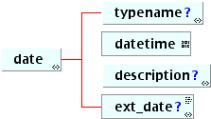
Elements:
Example:
<date>
<typename>
<tysource sourcetype="imsdefault"/>
<tyvalue>Award</tyvalue>
</typename>
<datetime>2000:11:06</datetime>
<description>
<short>The date of the ward</short>
</description>
</date>
Description: This element presents the default vocabulary that is made available to identify the type of date information. If the standard vocabulary is insufficient then an alternative entry must be used through the <tysource> element.
Multiplicity: Occurs zero or once within the <activity> element.
Attributes: None.
Description: The actual date and time entry. The format of this information is based upon the ISO8601 standard i.e. YYYY:MM:DDTHH:MM:SS for year, month, day, hour, minute and second entries respectively. The entry format is a string.
Attributes: None.
Description: The priority to be assigned to the encapsulating data object. For example, this is used to define the priority of a goal and/or its associated sub-goals. The entry format is a string.
Example:
<priority>Primary</priority>
Description: The status of a variety of data objects is supported using this structure. A data object may have several associated states but each status must be transferred using its own data structure.

Figure 3.31 <status> elements.
Elements:
Example:
<status>
<typename>
<tysource sourcetype="imsdefault"/>
<tyvalue>Active</tyvalue>
</typename>
<date>
<typename>
<tysource sourcetype="imsdefault"/>
<tyvalue>Entered</tyvalue>
</typename>
<datetime>1926:3:30</datetime>
</date>
<description>
<short>Active operation</short>
</description>
</status>
Description: This element presents the default vocabulary that is made available to identify the type of status information. If the standard vocabulary is insufficient then an alternative entry must be used through the <tysource> element.
Multiplicity: Occurs zero or once within the <status> element.
Attributes: None.
Description: The product data structure is used to contain the materials created by the learner. These materials may be created as part of formal activities and can take any electronic form e.g. text, graphic, etc.
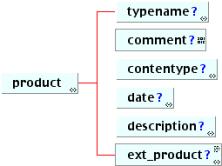
Figure 3.32 <product> elements.
Attributes: None.
Elements:
Example:
<product>
<typename>
<tysource sourcetype="imsdefault"/>
<tyvalue>Coursework</tyvalue>
</typename>
<contentype>
<referential>
<indexid>product_01</indexid>
</referential>
</contentype>
<description>
<full>
<media mediamode="text" mimetype="image/gif" encoding="uri">student1/essay1.doc
</media>
</full>
</description>
</product>
Description: This element presents the default vocabulary that is made available to identify the type of product information. If the standard vocabulary is insufficient then an alternative entry must be used through the <tysource> element.
Multiplicity: Occurs zero or once within the <roduct> element.
Attributes: None.
Description: The typename data structure is used to extend the basic vocabularies defined for a particular data structure. This extension mechanism is based upon referencing the new vocabulary set followed by identifying the term selected from that vocabulary. It is possible to simply state the selected phrase without defining reference set however this means that it will not be possible for the receiving system to validate the selection against a known reference vocabulary.

Figure 3.33 <typename> elements.
Attributes: None.
Elements:
Example:
<typename>
<tysource sourcetype="List">Monday, Tuesday, Wednesday, Thursday, Friday</tysource>
<tyvalue>Tuesday</tyvalue>
</typename>
Description: The tysource element is used to define the set of entries that constitute the vocabulary. This extension can be realised through the actual phrases themselves, a URI to a file containing the vocabulary or to an external identifier of that vocabulary.
Attributes:
Elements: None.
Description: The tyvalue element is used to select the entry in the vocabulary identified using the <tysource> element.
Attributes:
Elements: None.
Description: The fieldlabel element is used to construct arbitrarily named data structures. The fieldlabel entry is used to state the name of the associated data field with the fielddata element containing the actual value of the data field. Multiple occurrences can be used to construct complex data structures.
![]()
Figure 3.34 <fieldlabel> elements.
Attributes: None.
Elements:
Example:
<fieldlabel>
<typename>
<tyvalue>Grade</tyvalue>
</typename>
</fieldlabel>
Description: The fielddata element is used to store data in an arbitrarily defined data structure. This element is always used in conjunction with the fieldtype element. The fieldlabel element names the data field and the fielddata gives the associated data for that field.
Attributes: None.
Elements: None.
Example:
<fielddata>data</fielddata>
Description: This element is used to contain the electronic materials themselves. Each piece of material is contained within its own element.
Attributes:
Elements: None.
Example:
<media mediamode="Image" mimetype="image/gif" contentreftype="uri">directoryname/filename.gif
</media>
Description: The text element is used to contain any text entry information e.g. a paragraph of text submitted as content.
Attributes:
Elements: None.
Example:
<text xml:lang="en">Any string of any language.</text>
Description: The organisation element is used to identify the name and type of organisation that is to be associated with a particular data entry e.g. the body responsible for awarding a qualification.

Figure 3.35 <organization> elements.
Attributes: None.
Elements:
Example:
<organization>
<typename>
<tysource sourcetype="imsdefault"/>
<tyvalue>Education</tyvalue>
</typename>
<description>
<short>MIT</short>
</description>
</organization>
Description: This element presents the default vocabulary that is made available to identify the type of organization information. If the standard vocabulary is insufficient then an alternative entry must be used through the <tysource> element.
Multiplicity: Occurs zero or once within the <organization> element.
Attributes: None.
Description: The exrefrecord element is used to reference external content that can have any format. The format of the material and the material itself is defined either by inclusion in the data structure or by external reference to it.
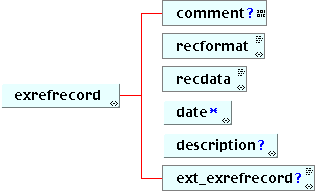
Figure 3.36 <exrefrecord> elements.
Attributes: None.
Elements:
Example:
<exrefrecord>
recformat>MSWord98</recformat>
<recdata uri="directoryname/filename.doc"/>
<date>
<stddate mode="Award"/>
<datetime>1920:9:30</datetime>
</date>
</exrefrecord>
Description: The recformat element is used to define the format of the material. This format could be defined explicitly as a file type e.g. ‘pdf’, or detailed description of the format using a predefined language (this language is outside the scope of this specification).
Attributes:
Elements: ANY.
Description: The recdata element is used to contain or to reference the actual material itself.
Attributes:
Elements: ANY.
Description: The sourcedid element is used to contain the LIP’s global user identifier. This element is a placeholder for that information, the manner in which it is generated is beyond the scope of this specification.

Figure 3.37 <sourcedid> elements.
Attributes: None.
Elements:
Example:
<sourcedid>
<source>Identifier Allocation Identity</source>
<id>Generic user identifier</id>
</sourcedid>
Description: The source identifier of the sourcedid. This source is the globally unique identifier assigned to the organisation responsible for the allocation of the unique identifier to this data structure.
Attributes: None.
Elements: None.
Description: The unique identifier assigned to the associated data structure. This identifier is unique in the context of the ‘source’ identifier. Together the ‘source’ and ‘id’ elements are the globally unique identifier for the data structure. It is the responsibility of the organisation identified by the source to uniquely allocate the ‘id’ identifiers.
Attributes: None.
Elements: None.
Description: The indexing facility for the data object. This index reference is unique with respect to the core learner ‘sourcedid’. Multiple references to the same data object should entail the use of the same ‘indexid’. The entry format is a string
Attributes: None.
Elements: None.
The XML Binding has been realised as XSD and DTD. The DTD realisation, shown in Appendix A, is a single file. The XSD is implemented a series of files which are linked using the XML XSD ‘include’ statement. The reasons for this approach are:
The XSD files created to realise the binding are (the actual contents of these files are listed in Appendix A):
The ‘include’ hierarchy for these files is shown in Figure 4.1 (all of these files have ‘v1p0.xsd’ as their extension and start with the string ‘ims_lip_’).
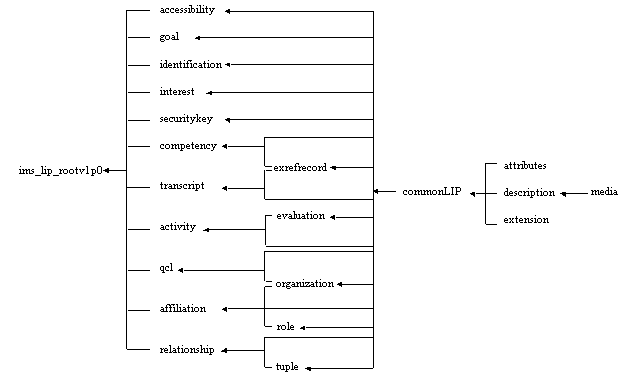
Figure 4.1 XML schema inclusion hierarchy.
Figure 4.1 should be read from left to right and top to bottom. Thus, the root file, ‘ims_lip_rootv1p0.xsd’, includes the eleven core data objects, each of which include the ‘commonLIP’ file plus others as appropriate.
Each of the following simple examples focuses on one of the core data structures. In each case it is assumed that the full set of information is being supplied. Each of the following examples refers to the same learner, identified by the ‘sourcedid’ of <source> ‘IMS_LIP_V1p0_Example’ and <id> ‘1001’.
The <identification> example presents the details for a ‘Sherlock Holmes’. The details include his formatted name, name, address, telephone, demographic and agent details.
1
2
3
4
5
6
7
8
9
10
11
12
13
14
16
17
18
19
20
21
22
23
24
25
26
27
28
29
30
31
32
33
34
35
36
37
38
39
40
41
42
43
44
45
46
47
48
49
50
51
52
53
54
55
56
57
58
59
60
61
62
63
64
65
66
67
68
69
70
71
72
73
74
75
76
77
78
79
80
81
82
83
84
85
86
87
88
89
90
91
92
93
94
95
96
97
98
99
100
101
102
103
104
105
106
107
108
109
110
111
112
113
114
115
116
117
118
119
120
121
122
123
124
125
126
127
128
129
130
131
132
133
134
<learnerinformation>
<comment>An example of LIP Identification information.</comment>
<contentype>
<referential>
<sourcedid>
<source>IMS_LIP_V1p0_Example</source>
<id>1001</id>
</sourcedid>
</referential>
</contentype>
<identification>
<comment>-----------------------------------------Identification</comment>
<contentype>
<referential>
<indexid>identification_01</indexid>
</referential>
</contentype>
<formname>
<typename>
<tysource sourcetype="imsdefault"/>
<tyvalue>Preferred</tyvalue>
</typename>
<comment>---------------------------Formatted Name details</comment>
<contentype>
<referential>
<indexid>formname_01</indexid>
</referential>
</contentype>
<text>Mr Sherlock Holmes</text>
</formname>
<name>
<typename>
<tysource sourcetype="imsdefault"/>
<tyvalue>Preferred</tyvalue>
</typename>
<comment>-------------------------------------Name details</comment>
<contentype>
<referential>
<indexid>name_01</indexid>
</referential>
</contentype>
<partname>
<typename>
<tysource sourcetype="imsdefault"/>
<tyvalue>First</tyvalue>
</typename>
<text>Sherlock</text>
</partname>
<partname>
<typename>
<tysource sourcetype="imsdefault"/>
<tyvalue>Last</tyvalue>
</typename>
<text>Holmes</text>
</partname>
</name>
<address>
<typename>
<tysource sourcetype="imsdefault"/>
<tyvalue>Permanent</tyvalue>
</typename>
<comment>---------------------------------Address details</comment>
<contentype>
<referential>
<indexid>address_01</indexid>
</referential>
</contentype>
<street>
<streetname>Baker Street</streetname>
<aptnumber>22</aptnumber>
<aptnumsuffix>b</aptnumsuffix>
</street>
<city>London</city>
<country>England</country>
</address>
<contactinfo>
<typename>
<tysource sourcetype="imsdefault"/>
<tyvalue>Private</tyvalue>
</typename>
<comment>----------------------------------Contact details</comment>
<contentype>
<referential>
<indexid>contactinfo_01</indexid>
</referential>
</contentype>
<telephone>
<countrycode>44</countrycode>
<areacode>020</areacode>
<indnumber>6472239</indnumber>
</telephone>
</contactinfo>
<demographics>
<typename>
<tysource sourcetype="imsdefault"/>
<tyvalue>Adult</tyvalue>
</typename>
<comment>------------------------------Demographic details</comment>
<contentype>
<referential>
<indexid>demographics_01</indexid>
</referential>
</contentype>
<gender gender="M"/>
<date>
<typename>
<tysource sourcetype="imsdefault"/>
<tyvalue>Birth</tyvalue>
</typename>
<datetime>1901:04:01</datetime>
</date>
</demographics>
<agent>
<typename>
<tysource sourcetype="imsdefault"/>
<tyvalue>Aide</tyvalue>
</typename>
<comment>------------------------------------Agent details</comment>
<contentype>
<referential>
<indexid>agent_01</indexid>
</referential>
</contentype>
<agentid>Dr.Watson</agentid>
<agentdomain>
<typename>
<tysource sourcetype="imsdefault"/>
<tyvalue>Medical</tyvalue>
</typename>
</agentdomain>
</agent>
</identification>
</learnerinformation>
The <goal> example shows that Sherlock Holmes’ primary objective is to arrest Moriarty. A picture of Moriarty has been included. Two sub-goals have also been described.
1
2
3
4
5
6
7
8
9
10
11
12
13
14
16
17
18
19
20
21
22
23
24
25
26
27
28
29
30
31
32
33
34
35
36
37
38
39
40
41
42
43
44
45
46
47
48
49
50
51
52
53
54
55
56
57
58
59
60
61
62
63
64
65
66
67
68
69
70
71
72
73
74
75
76
77
78
79
80
<learnerinformation>
<comment>An example of LIP Goal information.</comment>
<contentype>
<referential>
<sourcedid>
<source>IMS_LIP_V1p0_Example</source>
<id>1001</id>
</sourcedid>
</referential>
</contentype>
<goal>
<typename>
<tysource sourcetype="imsdefault"/>
<tyvalue>Work</tyvalue>
</typename>
<contentype>
<referential>
<indexid>goal_01</indexid>
</referential>
</contentype>
<date>
<typename>
<tysource sourcetype="imsdefault"/>
<tyvalue>Start</tyvalue>
</typename>
<datetime>1925</datetime>
</date>
<priority>Primary Objective</priority>
<status>
<typename>
<tysource sourcetype="imsdefault"/>
<tyvalue>Active</tyvalue>
</typename>
<date>
<typename>
<tysource sourcetype="imsdefault"/>
<tyvalue>Create</tyvalue>
</typename>
<datetime>1926:3:30</datetime>
</date>
</status>
<description>
<short>To arrest Moriarty</short>
<full>
<media mediamode="Image" mimetype="image/gif" contentreftype="uri">
sh/moriarty.gif
</media>
</full>
</description>
<goal>
<typename>
<tysource sourcetype="imsdefault"/>
<tyvalue>Work</tyvalue>
</typename>
<contentype>
<referential>
<indexid>goal_01_subgoal_01</indexid>
</referential>
</contentype>
<description>
<short>To locate Moriarty</short>
</description>
</goal>
<goal>
<typename>
<tysource sourcetype="imsdefault"/>
<tyvalue>Work</tyvalue>
</typename>
<contentype>
<referential>
<indexid>goal_01_subgoal_02</indexid>
</referential>
</contentype>
<description>
<short>Train Watson to be a competent detective.</short>
</description>
</goal>
</goal>
</learnerinformation>
In the <qcl> example a first class honours degree awarded in 1920 from Cambridge University is identified. An electronic ‘gif’ image of the certificate is also included.
1
2
3
4
5
6
7
8
9
10
11
12
13
14
16
17
18
19
20
21
22
23
24
25
26
27
28
29
30
31
32
33
34
35
36
37
38
39
40
41
42
43
44
45
46
47
48
<learnerinformation>
<comment>An example of LIP Qualification, Certification and Licence.</comment>
<contentype>
<referential>
<sourcedid>
<source>IMS_LIP_V1p0_Example</source>
<id>1001</id>
</sourcedid>
</referential>
</contentype>
<qcl>
<typename>
<tysource sourcetype="imsdefault"/>
<tyvalue>Qualification</tyvalue>
</typename>
<contentype>
<referential>
<indexid>qcl_01</indexid>
</referential>
</contentype>
<title>MA Criminology</title>
<organization>
<typename>
<tysource sourcetype="imsdefault"/>
<tyvalue>Educational</tyvalue>
</typename>
<description>
<short>Cambridge University</short>
</description>
</organization>
<level><text>First Class Honours</text></level>
<date>
<typename>
<tysource sourcetype="imsdefault"/>
<tyvalue>Award</tyvalue>
</typename>
<datetime>1920</datetime>
</date>
<description>
<full>
<media mediamode="Image" mimetype="image/gif"
contentreftype="uri">holmes/degree.gif
</media>
</full>
</description>
</qcl>
</learnerinformation>
In the <activity> the summary information concerning a course is presented. This summary information describes the length of the course, the credit score and includes reference to the thesis written by the student and the accompanying tutor’s testimonial.
1
2
3
4
5
6
7
8
9
10
11
12
13
14
16
17
18
19
20
21
22
23
24
25
26
27
28
29
30
31
32
33
34
35
36
37
38
39
40
41
42
43
44
45
46
47
48
49
50
51
52
53
54
55
56
57
58
59
60
61
62
63
64
65
66
67
68
69
70
71
72
73
74
75
76
77
78
79
80
81
82
83
84
85
86
87
88
89
90
91
92
93
94
95
96
97
98
99
100
101
102
103
104
105
106
107
108
109
110
111
112
113
114
115
116
117
118
119
120
121
122
123
124
125
126
127
128
129
130
131
132
133
134
135
136
137
138
139
140
141
142
143
144
145
146
147
148
149
<learnerinformation>
<comment>An example of LIP Activity information.</comment>
<contentype>
<referential>
<sourcedid>
<source>IMS_LIP_V1p0_Example</source>
<id>1001</id>
</sourcedid>
</referential>
</contentype>
<activity>
<typename>
<tysource sourcetype="imsdefault"/>
<tyvalue>Education</tyvalue>
</typename>
<contentype>
<referential>
<indexid>activity_1</indexid>
</referential>
</contentype>
<date>
<typename>
<tysource sourcetype="imsdefault"/>
<tyvalue>Award</tyvalue>
</typename>
<datetime>1919:7</datetime>
</date>
<status>
<typename>
<tysource sourcetype="imsdefault"/>
<tyvalue>Completed</tyvalue>
</typename>
<date>
<typename>
<tysource sourcetype="imsdefault"/>
<tyvalue>Finish</tyvalue>
</typename>
<datetime>1919:6</datetime>
</date>
</status>
<units>
<unitsfield>
<fieldlabel>
<typename>
<tyvalue>CreditNumber</tyvalue>
</typename>
</fieldlabel>
<fielddata>10</fielddata>
</unitsfield>
</units>
<learningactivityref>
<text>Degree in Philiosphy</text>
</learningactivityref>
<definition>
<typename>
<tysource sourcetype="imsdefault"/>
<tyvalue>Curriculum</tyvalue>
</typename>
<contentype>
<referential>
<indexid>degreecourse</indexid>
</referential>
</contentype>
<definitionfield>
<fieldlabel>
<typename>
<tyvalue>Duration</tyvalue>
</typename>
</fieldlabel>
<fielddata>3</fielddata>
</definitionfield>
</definition>
<product>
<typename>
<tysource sourcetype="imsdefault"/>
<tyvalue>Coursework</tyvalue>
</typename>
<contentype>
<referential>
<indexid>activity_product_01</indexid>
</referential>
</contentype>
<description>
<short>Thesis on violins</short>
<full>
<media mediamode="Text" mimetype="text/word" contentreftype="uri">
sh/thesis.doc
</media>
</full>
</description>
</product>
<testimonial>
<typename>
<tysource sourcetype="imsdefault"/>
<tyvalue>Academic</tyvalue>
</typename>
<contentype>
<referential>
<indexid>activity_testimonial_01</indexid>
</referential>
</contentype>
<description>
<short>Tutors reference</short>
<full>
<media mediamode="Text" mimetype="text/word" contentreftype="uri">
tutor/ref.doc
</media>
</full>
</description>
</testimonial>
<evaluation>
<contentype>
<referential>
<indexid>activity_evaluation_01</indexid>
</referential>
</contentype>
<result>
<interpretscore>
<fieldlabel>
<typename>
<tyvalue>MinScore</tyvalue>
</typename>
</fieldlabel>
<fielddata>0</fielddata>
</interpretscore>
<interpretscore>
<fieldlabel>
<typename>
<tyvalue>MaxScore</tyvalue>
</typename>
</fieldlabel>
<fielddata>100</fielddata>
</interpretscore>
<score>
<fieldlabel>
<typename>
<tyvalue>Total</tyvalue>
</typename>
</fieldlabel>
<fielddata>80</fielddata>
</score>
</result>
</evaluation>
<description>
<short>Final degree information.</short>
</description>
</activity>
</learnerinformation>
In this <competency> format external reference is made to a document that contains the competencies. The file containing the context for the competencies description is also supplied.
1
2
3
4
5
6
7
8
9
10
11
12
13
14
16
17
18
19
20
21
22
23
24
25
26
27
28
29
30
31
32
33
<learnerinformation>
<comment>An example of LIP Competency information.</comment>
<contentype>
<referential>
<sourcedid>
<source>IMS_LIP_V1p0_Example</source>
<id>1001</id>
</sourcedid>
</referential>
</contentype>
<competency>
<contentype>
<referential>
<indexid>competency_01</indexid>
</referential>
</contentype>
<exrefrecord>
<recformat uri="compformats/criminology.doc"/>
<recdata uri="holmes/competency.doc"/>
<date>
<typename>
<tysource sourcetype="imsdefault"/>
<tyvalue>Award</tyvalue>
</typename>
<datetime>1927:10:21</datetime>
</date>
</exrefrecord>
<description>
<short>Competencies in Criminology</short>
</description>
</competency>
</learnerinformation>
In this <transcript> format external reference is made to a document that contains the transcript. The file containing the context for the transcript description is also supplied.
1
2
3
4
5
6
7
8
9
10
11
12
13
14
16
17
18
19
20
21
22
23
24
25
26
27
28
29
30
31
32
33
34
35
36
37
<learnerinformation>
<comment>An example of LIP Transcript information.</comment>
<contentype>
<referential>
<sourcedid>
<source>IMS_LIP_V1p0_Example</source>
<id>1001</id>
</sourcedid>
</referential>
</contentype>
<transcript>
<typename>
<tysource sourcetype="imsdefault"/>
<tyvalue>Academic</tyvalue>
</typename>
<contentype>
<referential>
<indexid>transcript_01</indexid>
</referential>
</contentype>
<exrefrecord>
<recformat>MSWord98</recformat>
<recdata uri="holmes/cambridge_degree.doc"/>
<date>
<typename>
<tysource sourcetype="imsdefault"/>
<tyvalue>Award</tyvalue>
</typename>
<datetime>1920:9:30</datetime>
</date>
</exrefrecord>
<description>
<short>Cambridge University Transcript</short>
</description>
</transcript>
</learnerinformation>
The <accessibility> example shows the language proficiencies in ‘French’, and an input technology preference. The <disability> and <eligibility> elements are just frameworks - these will be developed further in later releases of the specification.
1
2
3
4
5
6
7
8
9
10
11
12
13
14
16
17
18
19
20
21
22
23
24
25
26
27
28
29
30
31
32
33
34
35
36
37
38
39
40
41
42
43
44
45
46
47
48
49
50
51
52
53
54
55
56
57
58
59
60
61
62
63
64
<learnerinformation>
<comment>An example of LIP Accessibility information.</comment>
<contentype>
<referential>
<sourcedid>
<source>IMS_LIP_V1p0_Example</source>
<id>1001</id>
</sourcedid>
</referential>
</contentype>
<accessibility>
<contentype>
<referential>
<indexid>accessibility_01</indexid>
</referential>
</contentype>
<language>
<typename>
<tysource sourcetype="imsdefault"/>
<tyvalue>German</tyvalue>
</typename>
<comment>-----------------------------------------Language</comment>
<contentype>
<referential>
<indexid>language_01</indexid>
</referential>
</contentype>
<proficiency profmode="OralSpeak">Excellent</proficiency>
<proficiency profmode="OralComp">Excellent</proficiency>
<proficiency profmode="Read">Good</proficiency>
<proficiency profmode="Write">Poor</proficiency>
</language>
<preference>
<typename>
<tysource sourcetype="imsdefault"/>
<tyvalue>InputTech</tyvalue>
</typename>
<comment>---------------------------------------Preference</comment>
<contentype>
<referential>
<indexid>preference_01</indexid>
</referential>
</contentype>
<prefcode>Large Font Display Devices</prefcode>
</preference>
<eligibility>
<comment>--------------------------------------Eligibility</comment>
<contentype>
<referential>
<indexid>eligibility_01</indexid>
</referential>
</contentype>
</eligibility>
<disability>
<comment>---------------------------------------Disability</comment>
<contentype>
<referential>
<indexid>disability_01</indexid>
</referential>
</contentype>
</disability>
</accessibility>
</learnerinformation>
The interest is Sherlock Holmes’ hobby of playing the violin. A picture of the violin is included as a product from the hobby.
1
2
3
4
5
6
7
8
9
10
11
12
13
14
16
17
18
19
20
21
22
23
24
25
26
27
28
29
30
31
32
33
34
35
36
37
38
39
40
41
42
43
44
45
46
47
48
49
50
51
52
<learnerinformation>
<comment>An example of LIP Interest information.</comment>
<contentype>
<referential>
<sourcedid>
<source>IMS_LIP_V1p0_Example</source>
<id>1001</id>
</sourcedid>
</referential>
</contentype>
<interest>
<typename>
<tysource sourcetype="imsdefault"/>
<tyvalue>Recreational</tyvalue>
</typename>
<contentype>
<referential>
<indexid>interest_01</indexid>
</referential>
</contentype>
<product>
<typename>
<tysource sourcetype="imsdefault"/>
<tyvalue>Portfolio</tyvalue>
</typename>
<contentype>
<referential>
<indexid>product_01</indexid>
</referential>
</contentype>
<date>
<typename>
<tysource sourcetype="imsdefault"/>
<tyvalue>Create</tyvalue>
</typename>
<datetime>1928:10:21</datetime>
</date>
<description>
<short>A picture of the violin</short>
<full>
<media mediamode="Image" mimetype="image/gif" contentreftype="uri">
sh/violin.gif
</media>
</full>
</description>
</product>
<description>
<short>Music - playing the violin</short>
</description>
</interest>
</learnerinformation>
The <affiliation> example describes Sherlock Holmes’ membership of the London branch of the ‘Royal Institution of Criminology’ and his role as treasurer in that organisation.
1
2
3
4
5
6
7
8
9
10
11
12
13
14
16
17
18
19
20
21
22
23
24
25
26
27
28
29
30
31
32
33
34
35
36
37
38
39
40
41
42
43
44
45
46
47
48
49
50
51
52
53
54
55
56
57
58
59
60
61
62
63
64
65
66
67
68
69
70
71
72
73
74
75
76
77
78
<learnerinformation>
<comment>An example of LIP Affiliation information.</comment>
<contentype>
<referential>
<sourcedid>
<source>IMS_LIP_V1p0_Example</source>
<id>1001</id>
</sourcedid>
</referential>
</contentype>
<affiliation>
<typename>
<tysource sourcetype="imsdefault"/>
<tyvalue>Professional</tyvalue>
</typename>
<contentype>
<referential>
<indexid>affiliation_01</indexid>
</referential>
</contentype>
<classification>Fellow</classification>
<affiliationid>2457923A</affiliationid>
<role>
<typename>
<tysource sourcetype="imsdefault"/>
<tyvalue>Officer</tyvalue>
</typename>
<contentype>
<referential>
<indexid>affiliation_role_01</indexid>
</referential>
</contentype>
<date>
<typename>
<tysource sourcetype="imsdefault"/>
<tyvalue>Start</tyvalue>
</typename>
<datetime>1924:04:01</datetime>
</date>
<date>
<typename>
<tysource sourcetype="imsdefault"/>
<tyvalue>Finish</tyvalue>
</typename>
<datetime>1925:03:31</datetime>
</date>
<description>
<short>Treasurer for the Local Branch of Criminology</short>
</description>
</role>
<organization>
<typename>
<tysource sourcetype="imsdefault"/>
<tyvalue>Professional</tyvalue>
</typename>
<description>
<short>Royal Institution of Criminology: London Branch</short>
</description>
</organization>
<date>
<typename>
<tysource sourcetype="imsdefault"/>
<tyvalue>Join</tyvalue>
</typename>
<datetime>1922</datetime>
</date>
<status>
<typename>
<tysource sourcetype="imsdefault"/>
<tyvalue>Active</tyvalue>
</typename>
</status>
<description>
<short>All fees paid</short>
</description>
</affiliation>
</learnerinformation>
The <securitykey> example defines two passwords that are associated with the learner. The actual passwords themselves have been included however these should be encrypted before inclusion in the instance.
1
2
3
4
5
6
7
8
9
10
11
12
13
14
16
17
18
19
20
21
22
23
24
25
26
27
28
29
30
31
32
33
34
35
36
37
38
39
<learnerinformation>
<comment>An example of LIP Securitykey information.</comment>
<contentype>
<referential>
<sourcedid>
<source>IMS_LIP_V1p0_Example</source>
<id>1001</id>
</sourcedid>
</referential>
</contentype>
<securitykey>
<typename>
<tysource sourcetype="imsdefault"/>
<tyvalue>Password</tyvalue>
</typename>
<contentype>
<referential>
<indexid>securitykey_1</indexid>
</referential>
</contentype>
<keyfields>
<fieldlabel>
<typename>
<tyvalue>PersonalPassword</tyvalue>
</typename>
</fieldlabel>
<fielddata>asits9</fielddata>
</keyfields>
<keyfields>
<fieldlabel>
<typename>
<tyvalue>LMSPassword</tyvalue>
</typename>
</fieldlabel>
<fielddata>moriarty</fielddata>
</keyfields>
</securitykey>
</learnerinformation>
The relationship defined in this example is equivalent to saying that: the degree warded to Sherlock Holmes on the basis of the detailed transcript.
1
2
3
4
5
6
7
8
9
10
11
12
13
14
16
17
18
19
20
21
22
23
24
25
26
27
28
29
30
31
32
33
34
35
36
37
38
39
40
41
42
43
44
<learnerinformation>
<comment>An example of LIP Relationship information.</comment>
<contentype>
<referential>
<sourcedid>
<source>IMS_LIP_V1p0_Example</source>
<id>1001</id>
</sourcedid>
</referential>
</contentype>
<relationship>
<typename>
<tysource sourcetype="imsdefault"/>
<tyvalue>Qcl</tyvalue>
</typename>
<contentype>
<referential>
<indexid>relationship_01</indexid>
</referential>
</contentype>
<tuple>
<tuplesource>
<sourcedid>
<source>IMS_LIP_V1p0_Example</source>
<id>1001</id>
</sourcedid>
<indexid>qcl_01</indexid>
</tuplesource>
<tuplerelation>
<typename>
<tyvalue>results_from</tyvalue>
</typename>
</tuplerelation>
<tupledest>
<sourcedid>
<source>IMS_LIP_V1p0_Example</source>
<id>1001</id>
</sourcedid>
<indexid>transcript_01</indexid>
</tupledest>
</tuple>
</relationship>
</learnerinformation>
<!ENTITY % lang.attr "xml:lang CDATA 'en'">
<!ENTITY % uri.attr " uri CDATA #IMPLIED">
<!ENTITY % profmode.attr " profmode (Write | Read | OralSpeak | OralComp ) #REQUIRED">
<!ENTITY % entityref.attr " entityref ENTITY #IMPLIED">
<!ENTITY % source.attr "source (text | uri | entityref | uid ) #REQUIRED">
<!ELEMENT comment (#PCDATA )>
<!ATTLIST comment %lang.attr;
e-dtype NMTOKEN #FIXED 'string' >
<!ELEMENT priority (#PCDATA )>
<!ATTLIST priority %lang.attr;
e-dtype NMTOKEN #FIXED 'string' >
<!ELEMENT source (#PCDATA )>
<!ATTLIST source e-dtype NMTOKEN #FIXED 'string' >
<!ELEMENT id (#PCDATA )>
<!ATTLIST id e-dtype NMTOKEN #FIXED 'string' >
<!ELEMENT short (#PCDATA )>
<!ATTLIST short %lang.attr;
e-dtype NMTOKEN #FIXED 'string' >
<!ELEMENT long (#PCDATA )>
<!ATTLIST long %lang.attr;
e-dtype NMTOKEN #FIXED 'string' >
<!ELEMENT fielddata (#PCDATA )>
<!ATTLIST fielddata e-dtype NMTOKEN #FIXED 'string' >
<!ELEMENT proficiency (#PCDATA )>
<!ATTLIST proficiency %lang.attr;
%profmode.attr;
e-dtype NMTOKEN #FIXED 'string' >
<!ELEMENT pobox (#PCDATA )>
<!ATTLIST pobox %lang.attr;
e-dtype NMTOKEN #FIXED 'string' >
<!ELEMENT locality (#PCDATA )>
<!ATTLIST locality %lang.attr;
e-dtype NMTOKEN #FIXED 'string' >
<!ELEMENT city (#PCDATA )>
<!ATTLIST city %lang.attr;
e-dtype NMTOKEN #FIXED 'string' >
<!ELEMENT country (#PCDATA )>
<!ATTLIST country %lang.attr;
e-dtype NMTOKEN #FIXED 'string' >
<!ELEMENT statepr (#PCDATA )>
<!ATTLIST statepr %lang.attr;
e-dtype NMTOKEN #FIXED 'string' >
<!ELEMENT region (#PCDATA )>
<!ATTLIST region %lang.attr;
e-dtype NMTOKEN #FIXED 'string' >
<!ELEMENT postcode (#PCDATA )>
<!ATTLIST postcode %lang.attr;
e-dtype NMTOKEN #FIXED 'string' >
<!ELEMENT timezone (#PCDATA )>
<!ATTLIST timezone %lang.attr;
e-dtype NMTOKEN #FIXED 'time.tz' >
<!ELEMENT nonfieldedstreetaddress (#PCDATA )>
<!ATTLIST nonfieldedstreetaddress %lang.attr;
e-dtype NMTOKEN #FIXED 'string' >
<!ELEMENT complex (#PCDATA )>
<!ATTLIST complex %lang.attr;
e-dtype NMTOKEN #FIXED 'string' >
<!ELEMENT streetnumber (#PCDATA )>
<!ATTLIST streetnumber %lang.attr;
e-dtype NMTOKEN #FIXED 'string' >
<!ELEMENT streetprefix (#PCDATA )>
<!ATTLIST streetprefix %lang.attr;
e-dtype NMTOKEN #FIXED 'string' >
<!ELEMENT streetname (#PCDATA )>
<!ATTLIST streetname %lang.attr;
e-dtype NMTOKEN #FIXED 'string' >
<!ELEMENT streetype (#PCDATA )>
<!ATTLIST streetype %lang.attr;
e-dtype NMTOKEN #FIXED 'string' >
<!ELEMENT streetsuffix (#PCDATA )>
<!ATTLIST streetsuffix %lang.attr;
e-dtype NMTOKEN #FIXED 'string' >
<!ELEMENT apttype (#PCDATA )>
<!ATTLIST apttype %lang.attr;
e-dtype NMTOKEN #FIXED 'string' >
<!ELEMENT aptnumprefix (#PCDATA )>
<!ATTLIST aptnumprefix %lang.attr;
e-dtype NMTOKEN #FIXED 'string'>
<!ELEMENT aptnumber (#PCDATA )>
<!ATTLIST aptnumber %lang.attr;
e-dtype
NMTOKEN #FIXED 'string' >
<!ELEMENT aptnumsuffix (#PCDATA )>
<!ATTLIST aptnumsuffix %lang.attr;
e-dtype NMTOKEN #FIXED 'string' >
<!ELEMENT countrycode (#PCDATA )>
<!ATTLIST countrycode e-dtype NMTOKEN #FIXED 'int' >
<!ELEMENT indnumber (#PCDATA )>
<!ATTLIST indnumber e-dtype NMTOKEN #FIXED 'int' >
<!ELEMENT extnumber (#PCDATA )>
<!ATTLIST extnumber e-dtype NMTOKEN #FIXED 'int' >
<!ELEMENT placeofbirth (#PCDATA )>
<!ATTLIST placeofbirth %lang.attr;
e-dtype NMTOKEN #FIXED 'string' >
<!ELEMENT datetime (#PCDATA )>
<!ATTLIST datetime e-dtype NMTOKEN #FIXED 'dateTime' >
<!ELEMENT text (#PCDATA )>
<!ATTLIST text %uri.attr;
%entityref.attr;
%lang.attr;
e-dtype NMTOKEN #FIXED 'string' >
<!ELEMENT title (#PCDATA )> <!ATTLIST title %lang.attr; e-dtype NMTOKEN #FIXED 'string' > <!ELEMENT prefcode (#PCDATA )> <!ATTLIST prefcode %lang.attr; e-dtype NMTOKEN #FIXED 'string' > <!ELEMENT registrationno (#PCDATA )> <!ATTLIST registrationno e-dtype NMTOKEN #FIXED 'string' > <!ELEMENT areacode (#PCDATA )> <!ATTLIST areacode e-dtype NMTOKEN #FIXED 'int' > <!ELEMENT gender EMPTY> <!ATTLIST gender gender (M | F | NA ) #REQUIRED > <!ELEMENT learnerinformation (comment? , contentype?, (identification | goal | qcl | activity | competency | transcript | accessibility | interest | affiliation | securitykey | relationship | ext_learnerinfo )* )> <!ATTLIST learnerinformation %lang.attr; > <!ELEMENT fieldlabel (typename )> <!ELEMENT sourcedid (source , id )> <!ELEMENT identification (comment? , contentype?, (formname | name | address | contactinfo | demographics| agent )* , ext_identification?)> <!ELEMENT preference (typename? ,comment? , contentype? ,prefcode? ,description? ,ext_preference?)> <!ELEMENT goal (typename? ,comment? , contentype? ,date* , priority? ,status? , description? ,goal* ,ext_goal?)> <!ELEMENT qcl (typename? ,comment? , contentype? ,title? , organization? ,registrationno? ,level? , date* ,description? ,ext_qcl?)> <!ELEMENT activity (typename? ,comment?, contentype?,date*, status?,units?, (learningactivityref |definition | product | testimonial | evaluation )* ,description? ,activity* , ext_activity?)> <!ELEMENT competency (comment?,contentype?,exrefrecord?,description?,ext_competency?)> <!ELEMENT interest (typename?,comment?, contentype?,product?, description?, ext_interest?)> <!ELEMENT affiliation (typename?, comment?, contentype?,classification?, affiliationid?,role* ,organization? ,date* , status? ,description? ,affiliation* , ext_affiliation?)> <!ELEMENT classification (#PCDATA )> <!ATTLIST classification %lang.attr; e-dtype NMTOKEN #FIXED 'string' > <!ELEMENT name (typename? ,comment? , contentype? ,partname*)> <!ELEMENT address (typename?,comment?, contentype?,pobox?, street?,locality?,city?, statepr?,region?,country?,postcode?,timezone?, geo?)> <!ELEMENT contactinfo (typename? ,comment? , contentype?, (telephone | facsimile | mobile | pager | email|web ) )> <!ELEMENT demographics (typename? ,comment? , contentype? ,representation* ,gender? ,date? , placeofbirth?, uid? )> <!ELEMENT language (typename? ,comment? , contentype? ,proficiency* ,ext_language?)> <!ELEMENT disability (typename? ,comment? , contentype? ,ext_disability?)> <!ELEMENT securitykey (typename? ,comment? , contentype? ,keyfields* ,description? ,ext_securitykey?)> <!ELEMENT description (short | long | full )+> <!ELEMENT full (comment? ,media+ )> <!ELEMENT contentype (comment?, (referential | temporal | privacy )+ , ext_contentype?)> <!ELEMENT referential (sourcedid | indexid | (sourcedid , indexid ) )> <!ELEMENT temporal (typename? ,temporalfield+)> <!ELEMENT privacy (typename? ,privacyfield+ ,date* )> <!ELEMENT indexid (#PCDATA )> <!ATTLIST indexid e-dtype NMTOKEN #FIXED 'string' > <!ELEMENT status (typename? ,date? , description?)> <!ELEMENT partname (typename? ,text? )> <!ELEMENT street (nonfieldedstreetaddress?, complex?, streetnumber?, streetprefix?, streetname?, streetype?, streetsuffix?, apttype?, aptnumprefix?, aptnumber?, aptnumsuffix? )> <!ELEMENT telephone (countrycode? , areacode , indnumber , extnumber? )> <!ELEMENT email (#PCDATA )> <!ATTLIST email e-dtype NMTOKEN #FIXED 'string' > <!ELEMENT web (#PCDATA )> <!ATTLIST web e-dtype NMTOKEN #FIXED 'string' > <!ELEMENT representation (typename? , date* , description* )> <!ELEMENT date (typename? , datetime , description? , ext_date? )> <!ELEMENT organization (typename? ,description?)> <!ELEMENT level (text , level? )> <!ELEMENT exrefrecord (comment? , recformat , recdata , date* , description? , ext_exrefrecord? )>
<!ELEMENT role (typename?, comment?, contentype?, date*, status?, description?, role*, ext_role? )>
<!ELEMENT evaluation (typename? , comment? , contentype? , evaluationid? , date* , evalmetadata? , objectives* , status? , noofattempts? , duration* , result* , description? , evaluation* , ext_evaluation? )>
<!ELEMENT testimonial (typename? , comment? , contentype? , date* , description? , ext_testimonial?)>
<!ELEMENT definition (typename? ,comment? , contentype? , definitionfield* , description? , definition* , ext_definition? )>
<!ELEMENT evalmetadata (typename? , evalmetadatafield+)>
<!ELEMENT evalmetadatafield (fieldlabel , fielddata )>
<!ATTLIST evalmetadatafield %lang.attr; >
<!ELEMENT objectives (comment? , (media | contentref )+ , ext_objectives?)>
<!ATTLIST objectives view (All | Administrator | AdminAuthority | Assessor | Author | Candidate | InvigilatorProctor | Psychometrician | Scorer | Tutor ) 'All' >
<!ELEMENT result (comment?, ( (interpretscore | score )* | result* ) )>
<!ELEMENT product (typename?, comment?, contentype?, date?, description?, ext_product?)>
<!ELEMENT units (unitsfield+ )>
<!ELEMENT accessibility (comment? , contentype? , (language | eligibility | preference | disability )+ , ext_accessibility?)>
<!ELEMENT eligibility (typename? , comment? , contentype? , ext_eligibility?)>
<!ELEMENT formname (typename? , comment? , contentype? , text? )>
<!ELEMENT uid (#PCDATA )>
<!ATTLIST uid e-dtype NMTOKEN #FIXED 'string' >
<!ELEMENT agent (typename?, comment?, contentype?, agentid, agentdomain, description? )>
<!ELEMENT agentdomain (typename?)>
<!ELEMENT typename (tysource? , tyvalue )>
<!ELEMENT recformat ANY>
<!ATTLIST recformat %uri.attr;
%entityref.attr;>
<!ELEMENT recdata ANY>
<!ATTLIST recdata %uri.attr;
%entityref.attr;>
<!ELEMENT transcript (typename? ,comment? , contentype? ,exrefrecord? ,description? ,ext_transcript?)>
<!ELEMENT affiliationid (#PCDATA )>
<!ATTLIST affiliationid e-dtype NMTOKEN #FIXED 'string' >
<!ELEMENT learningactivityref (sourcedid | text )+>
<!ELEMENT relationship (typename?, comment?, contentype?,tuple?, description?,ext_relationship?)>
<!ELEMENT geo (lat , lon )>
<!ELEMENT lat (#PCDATA )>
<!ATTLIST lat e-dtype NMTOKEN #FIXED 'string' >
<!ELEMENT lon (#PCDATA )>
<!ATTLIST lon e-dtype NMTOKEN #FIXED 'string' >
<!ELEMENT evaluationid (#PCDATA )>
<!ATTLIST evaluationid e-dtype NMTOKEN #FIXED 'ID' >
<!ELEMENT noofattempts (#PCDATA )>
<!ATTLIST noofattempts e-dtype NMTOKEN #FIXED 'int' >
<!ELEMENT duration (fieldlabel , fielddata )>
<!ELEMENT tuple (tuplesource , tuplerelation , tupledest+)>
<!ELEMENT tuplesource (sourcedid? ,indexid )>
<!ELEMENT tuplerelation (typename , text?)>
<!ELEMENT tupledest (sourcedid? ,indexid )>
<!ELEMENT contentref (#PCDATA )>
<!ATTLIST contentref e-dtype NMTOKEN #FIXED 'ID' >
<!ELEMENT media (#PCDATA )>
<!ATTLIST media mediamode (Text | Image | Video | Audio | Applet |Application ) #REQUIRED
contentreftype (uri | entityref | Base-64 ) 'Base-64'
mimetype CDATA #REQUIRED >
<!ELEMENT tysource (#PCDATA )>
<!ATTLIST tysource sourcetype (imsdefault | list | proprietary | standard) 'imsdefault'
e-dtype NMTOKEN #FIXED 'string' >
<!ELEMENT tyvalue (#PCDATA )>
<!ATTLIST tyvalue %lang.attr;
e-dtype NMTOKEN #FIXED 'string' >
<!ELEMENT agentid (#PCDATA )>
<!ATTLIST agentid e-dtype NMTOKEN #FIXED 'string' >
<!ELEMENT interpretscore (fieldlabel , fielddata )>
<!ELEMENT score (fieldlabel , fielddata )>
<!ELEMENT facsimile (countrycode? ,areacode , indnumber , extnumber?)>
<!ELEMENT pager (countrycode? ,areacode , indnumber )>
<!ELEMENT mobile (countrycode? ,areacode , indnumber )>
<!ELEMENT temporalfield (fieldlabel , fielddata )>
<!ELEMENT privacyfield (fieldlabel , fielddata )>
<!ELEMENT definitionfield (fieldlabel , fielddata )>
<!ELEMENT unitsfield (fieldlabel , fielddata )>
<!ELEMENT keyfields (fieldlabel , fielddata )>
<!ELEMENT ext_accessibility ANY>
<!ELEMENT ext_goal ANY>
<!ELEMENT ext_interest ANY>
<!ELEMENT ext_evaluation ANY>
<!ELEMENT ext_learnerinfo ANY>
<!ELEMENT ext_contentype ANY>
<!ELEMENT ext_activity ANY>
<!ELEMENT ext_affiliation ANY>
<!ELEMENT ext_competency ANY>
<!ELEMENT ext_date ANY>
<!ELEMENT ext_definition ANY>
<!ELEMENT ext_disability ANY>
<!ELEMENT ext_eligibility ANY>
<!ELEMENT ext_exrefrecord ANY>
<!ELEMENT ext_identification ANY>
<!ELEMENT ext_language ANY>
<!ELEMENT ext_objectives ANY>
<!ELEMENT ext_preference ANY>
<!ELEMENT ext_product ANY>
<!ELEMENT ext_qcl ANY>
<!ELEMENT ext_relationship ANY>
<!ELEMENT ext_role ANY>
<!ELEMENT ext_securitykey ANY>
<!ELEMENT ext_testimonial ANY>
<!ELEMENT ext_transcript ANY>
Title
IMS Learner Information Package
XML Binding
Authors
Colin Smythe, Frank Tansey and Robby Robson
Version
Version 1.0
Version Date
9th March, 2001
Status
Final
Specification.
Summary
This document describes the Profiles XML binding for the
corresponding information model. The XML encoding is based on the
W3C XML Schema specification version 1.0.
Revision Information
9th March, 2001
Purpose
Defines how the Learner Information Package
Information Model is encoded in XML.
Document Location
lipbind01.html.
The following individuals contributed to the development of this document:
| Susan Beidler | PeopleSoft, USA |
| Geoff Collier | Saba Software, USA |
| Andy Heath | JISC/CETIS, UK |
| Wayne Martin | Miami-Dade Community College, USA |
| Bill Olivier | JISC/CETIS, UK |
| Tom Probert | Enterprise Computing, USA |
| Robby Robson | Saba Software, USA |
| Colin Smythe | Dunelm Services, UK |
| Frank Tansey | IMS, USA |
| Tom Wason | IMS, USA |
Version No. Release Date Comments Public Draft Specification v1.0 21st December, 2000 This is the first publicly available version of the IMS LIP XML Binding
Public Draft Specification. Final Specification v1.0 9th March, 2001 Version 1.0 of the IMS LIP XML Binding Final Specification.
IMS Global Learning Consortium, Inc. ("IMS") is
publishing the information contained in this IMS Learner Information Package XML
Binding ("Specification") for purposes of scientific, experimental, and
scholarly collaboration only.
IMS makes no warranty or representation
regarding the accuracy or completeness of the Specification.
This material
is provided on an "As Is" and "As Available" basis.
The Specification is
at all times subject to change and revision without notice.
It is your
sole responsibility to evaluate the usefulness, accuracy, and completeness of
the Specification as it relates to you.
IMS would appreciate receiving
your comments and suggestions.
Please contact IMS through our website at
http://www.imsglobal.org/
Please
refer to Document Name: IMS Learner Information Package XML Binding v1
Revision: March 2001